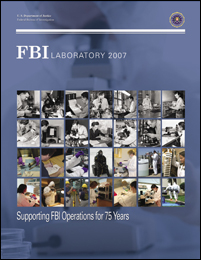
The FBI Laboratory 2007 Report may also be viewed online here:
FBI Laboratory 2007 Report (pdf).
U.S. Department of Justice
Federal Bureau of Investigation
2501 Investigation Parkway
Quantico, VA 22135
Table of Contents
Message from the FBI Laboratory Director
Terrorist Explosive Device Analytical Center
Explosives Unit
Forensic Analysis Branch
Evidence Control Unit
Quality Assurance and Training Unit
Cryptanalysis and Racketeering Records Unit
Firearms-Toolmarks Unit
Latent Print Operations Unit
Latent Print Support Unit
Questioned Documents Unit
Chemistry Unit
Combined DNA Index System Unit
DNA Analysis Unit-1
DNA Analysis Unit-2
Trace Evidence Unit
Operational Support Branch
Security Team
Administrative Unit
Counterterrorism and Forensic Science Research Unit
INNOVARi
Planning and Budget Unit
Special Projects Unit
Chemical-Biological Sciences Unit
Evidence Response Team Unit
Hazardous Materials Response Unit
Photographic Operations and Imaging Services Unit
Message from the FBI Laboratory Director
 |
| Dr. Joseph A. DiZinno |
The FBI Laboratory celebrated a milestone in 2007: 75 years of forensic science service. In the early 1920s and 1930s, law enforcement agencies, including the FBI, were only beginning to see the value of using science to solve crimes. In 1932, when the FBI moved a few pieces of laboratory equipment into room 802 of the Old Southern Railway Building in Washington, D.C., it was with the vision that the federal government could use its considerable knowledge and resources to help state and local law enforcement solve crimes and actually prevent crimes from occurring.
The FBI and the FBI Laboratory have changed more than anyone could have envisioned in 1932. Today the FBI Laboratory employs approximately 500 employees. FBI Laboratory examinations total one million or more each year and support law enforcement, intelligence, military, and forensic science partners around the world.
The theme of the 2007 annual report is “supporting the FBI mission through science and technology.” Each unit described in the ensuing pages directly supports the FBI’s priorities as outlined by the FBI Director: protecting the United States from terrorist attack and foreign intelligence activity; combating criminal activity that threatens the safety and security of society; preserving civil liberties; and providing leadership, intelligence, and law enforcement assistance to FBI partners. Doing so involves the core functions of collection; information dissemination and integration; analysis; and action. These functions closely parallel those of the Intelligence Cycle, which intelligence community partners—including the FBI—use to guide their efforts to ensure the safety and security of the United States and its allies.
The Laboratory has specialized units that respond to incidents and collect or facilitate the collection of evidence in the field. The Evidence Response Team Unit supports Evidence Response Teams in all 56 FBI field offices. The Explosives Unit specializes in evidence involving explosive and incendiary devices, and the Hazardous Materials Response Unit provides support at scenes involving chemical, biological, radiological, and nuclear materials. The Photographic Operations and Imaging Services Unit and the Special Projects Unit document the scene and collect data for such uses as crime scene reconstruction, courtroom exhibits and testimony, and forensic facial imaging.
Evidence collected in the field and submitted to the Laboratory may be examined in several units, depending on the nature of the evidence. Chemistry, Cryptanalysis, DNA, Firearms-Toolmarks, Latent Prints, Questioned Documents, and Trace Evidence may all receive items of evidence from the same case. Using state-of-the-art technology, the units conduct forensic examinations and develop information concerning suspects, witnesses, victims, or crime scenes that oftentimes is critical to investigators for prosecutions and also for exonerating the innocent. The examinations conducted at the Laboratory also assist the law enforcement and intelligence communities in identifying trends and obtaining a more complete picture of current threats. Research and development and advances in technology provide the Laboratory additional tools to help support the FBI’s mission.
In short, Laboratory personnel collect and analyze evidence and disseminate their findings to investigators, who integrate the information with what they already know and then act on it. As new evidence and intelligence develop or as other incidents occur, the cycle begins anew.
The Laboratory also relies on the expertise of personnel from other FBI Divisions. Legal counsel, public and congressional affairs, security, finance, information technology, and facilities maintenance are just some of the areas represented. These personnel are assigned to FBI Headquarters in Washington, D.C., but are physically located at the Laboratory in order to provide the services Laboratory personnel need to complete their missions. Private contractors with specialized experience round out the FBI staff. Of course, partnerships with other agencies are essential to the Laboratory’s continued success.
Today the FBI and other federal agencies are faced with great responsibility, as well as increased scrutiny and accountability. The FBI Laboratory performs forensic examinations every day in which people’s lives are at stake and justice hangs in the balance. FBI Laboratory personnel and partners are proud of their service and remain committed to meeting the high standards and expectations of those who depend on the Laboratory’s services.
Dr. Joseph A. DiZinno
Director
FBI Laboratory
Quantico , Virginia
Terrorist Explosive Device Analytical Center
A car bomb explodes at a police station in Baghdad, Iraq, killing and injuring dozens of police recruits, U.S. military personnel, and civilians. The explosive device is remotely detonated by a cell phone. No terrorists are injured in the attack or apprehended at the scene.
A suicide bomber walks into a crowded marketplace in Kabul, Afghanistan, and detonates a bomb that is concealed beneath his clothing. He kills 10 people, and dozens more are seriously wounded. The bomber dies in the attack.
In Mosul, Iraq, a U.S. military convoy is ambushed after a bomb that had been buried underground along the convoy’s route explodes. Marines in the disabled tank are attacked by terrorists with rocket-propelled grenades. A firefight ensues between the Marines and the terrorists. Four Marines lose their lives, and 10 terrorists are killed during the fighting.
These fictitious scenarios are based on real events that occur every day as the United States and its allies fight against terrorism overseas. At the FBI Laboratory, the Terrorist Explosive Device Analytical Center (TEDAC) provides critical intelligence needed to protect and defend innocent lives against the threat of terrorism.
The mission of the TEDAC is to coordinate and manage the unified efforts of law enforcement, intelligence, and military assets to forensically and technically exploit improvised explosive devices (IEDs) of interest to the U.S. government worldwide, in an effort to provide actionable intelligence to the offensive missions against terrorism and to the force protection mission.
Intelligence reports and TEDAC bulletins are disseminated directly to local, state, federal, and tribal law enforcement agencies, the U.S. military, and U.S. international partners in the war on terror. The TEDAC provides vital information to the U.S. intelligence community and especially to U.S. military forces fighting in Iraq and other overseas operations. Through forensic examinations, the TEDAC has successfully linked various IEDs to one another and to suspected terrorists.
IED evidence is submitted to the TEDAC directly from the scenes of terrorist attacks. TEDAC examinations consist of firearms and fingerprint processing in addition to the analysis of trace evidence (hairs, fibers, metals, and other material), electronic components, and mitochondrial DNA.
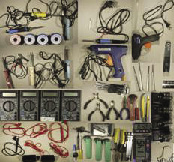 |
| Examples of tools and components received by TEDAC |
Since its inception in 2003, the TEDAC has received more than 24,000 IED submissions, all of which are in some form of processing at the FBI Laboratory. In 2007, the TEDAC received more than 9,000 IED submissions from Iraq and Afghanistan. The TEDAC identified more than 30 individuals by name as potential bomb makers based on latent fingerprints recovered from the IEDs. Trace evidence examinations resulted in the linkage of several IEDs to one another and to suspected terrorists. Nearly 100 terrorist associations were made as a result of electronic trend-analysis examinations. More than 50 associations of IEDs were made as a result of firearms examinations, and two terrorist suspects were identified as bomb makers as a result of mitochondrial DNA testing.
The following images depict examples of tools and components received by the TEDAC that can be used in making IEDs.
Explosives Unit
Since 1972, the Explosives Unit has supported the FBI’s mission to investigate and prevent bombing incidents. The unit’s staff of special agents, chemists, device physical scientists, device examiners, and information specialists work together to identify improvised explosive and incendiary devices; determine the types of explosives used; identify suspects; and provide support, liaison, and training to FBI field offices and other agencies and laboratories working bombing matters. The Explosives Reference Tool (EXPeRT), which is accessible to law enforcement via the FBI’s Bomb Data Center Special Interest Group on Law Enforcement Online (LEO), contains FBI Laboratory reports and evidentiary photographs, making it a key resource in forensic bombing examinations. By analyzing tactics, techniques, and procedures used by terrorist bombers, the EU can develop cutting-edge solutions to combat these emerging threats and ensure the continued leadership role the FBI Laboratory has come to play in terrorist bombing matters.
The FBI’s Hydrogen Peroxide Liquid Explosive Research Program
On March 15, 2004, a vehicle bomb was delivered to the U.S. Consulate in Karachi, Pakistan. The bomb was successfully disarmed by local authorities, and subsequent explosives chemical analysis by FBI Explosives Unit personnel determined that the explosive was composed of hydrogen peroxide. It was the first time that FBI Explosives Unit personnel had encountered a large bomb based on a potential liquid explosive composed of hydrogen peroxide. On April 10, 2004, authorities in Amman, Jordan, thwarted a terrorist attack and recovered a large quantity of chemicals, including a large quantity of hydrogen peroxide, presumably to be used to manufacture liquid explosives.
In August 2006, British authorities interrupted a terrorist plot to bring down multiple trans-Atlantic passenger flights originating in the United Kingdom and traveling to the United States. The plan involved smuggling hydrogen peroxide-based liquid explosives onto the airplanes and detonating them in flight. In early September 2007, German authorities foiled a major terrorist attack against U.S. and German interests. This plot also involved using hydrogen peroxide to manufacture bombs. These events highlight the substantial threat posed by hydrogen peroxide-based liquid explosives.
 |
| Manufacturing a 2000-pound liquid explosive bomb. The bomb is shown in the foreground. |
Since October 2005, scientists in the FBI Laboratory’s Explosives Unit and Counterterrorism and Forensic Science Research Unit have been conducting research to better understand the threat posed by these liquid explosives. The joint study consists of a comprehensive, detailed study of the safety hazards of these mixtures, their feasibility of manufacture, and their explosive performance at explosive weights ranging from 5 to 2000 pounds. Such a cradle-to-grave counterterrorist study of liquid peroxide-based explosives had never been initiated by the U.S. government before.
To date, more than 300 tests have been performed on various hydrogen peroxide-based liquid explosives. Explosives Unit personnel are often contacted by other domestic and international law enforcement agencies, intelligence agencies, research laboratories, and other federal agencies for the results of their research program. Less than one day after the foiled British terrorist plot was disclosed to the public, the FBI research program generated results detailing the nature of the threat and communicated the results to the FBI Director. The data assisted the U.S. Department of Homeland Security in developing restrictions on the amounts of liquids that the public could carry onboard an aircraft. Results from this research program also directly assisted the German authorities with the technical evaluation of their terrorist plot.
The foresight of the Explosives Unit and the Counterterrorism and Forensic Science Research Unit, coupled with rapid response and testing, directly contributed to the safety of the flying public and the arrest of the individuals involved in the German terrorist plot. The success of the Laboratory’s research program also has prompted other federal agencies to begin their own research initiatives.
Forensic Analysis Branch
The Forensic Analysis Branch (FAB) is the destination for most items of evidence submitted to the Laboratory for analysis. The Evidence Control Unit manages the flow of evidence through the Laboratory, tracking items as they move from unit to unit and providing status reports to contributors and Laboratory management along the way. A single item of evidence may be subject to many examinations in several units. For example, depending on the circumstances surrounding the case, a handwritten letter and the envelope it was mailed in would be examined in Questioned Documents, Trace Evidence, DNA, Chemistry, and Latent Prints. If written in code, the letter would also be examined by the Cryptanalysis and Racketeering Records Unit.
The variety and sheer number of examinations required for each item of evidence keep the FAB evidence-examining units extremely busy. In addition to examining evidence and issuing detailed, comprehensive reports on their findings, they also testify in court, provide training, conduct research, publish in and serve as referees for peer-reviewed journals, and remain proficient and knowledgeable in their areas of expertise.
The FAB’s Quality Assurance and Training Unit (QATU) assists the caseworking units in their mission by ensuring compliance with quality-control guidelines, proficiency-testing protocols, and accreditation-board requirements. The QATU also manages the Specialized Forensic Training Program, facilitates meetings for Laboratory-sponsored scientific working groups, and sponsors the annual Crime Laboratory Development Symposium.
The Forensic Analysis Branch is divided into two sections: Forensic Analysis, which encompasses the Cryptanalysis and Racketeering Records Unit, the Firearms-Toolmarks Unit, the Latent Print Operations Unit, the Latent Print Support Unit, and the Questioned Documents Unit; and Scientific Analysis, which contains the Chemistry Unit, the Combined DNA Index System Unit, the DNA Analysis Unit-1, the DNA Analysis Unit-2, and the Trace Evidence Unit.
Evidence Control Unit
The Evidence Control Unit (ECU) serves a fundamental role in supporting FBI operations by managing and tracking all evidence collected from crime scenes and sent to the FBI Laboratory for forensic examination.
The FBI Laboratory receives thousands of cases annually. Each case received has the potential of including from one to several thousand items of evidence. The ECU provides a central base for receiving and managing this evidence and is essential to communicating information to law enforcement contributors. ECU personnel establish and maintain liaison with contributors to acknowledge receipt of the evidence and to discuss pertinent case issues, as well as to provide status checks and advice and guidance in areas such as packaging and transporting evidence.
At the field level, the ECU provides advice and guidance to evidence-handling personnel through its Field Evidence Program. Nationwide, FBI field offices collect and store thousands of items of evidence
from crime scene investigations. To help manage this function, evidence items are bar-coded and recorded using handheld inventory scanners. In 2007 the ECU purchased new handheld evidence scanners with updated technology for all FBI field offices to more effectively and efficiently manage the thousands of items of evidence that are collected, tracked, and stored. Ensuring efficiency and accountability in the proper handling, storage, and tracking of evidence is essential to FBI evidence collection and ultimate prosecution.
The ECU’s role in the management of cases submitted to the FBI Laboratory as well as in providing guidance and direction at the field level through the Field Evidence Program ensures accountability in the administration of evidence and builds positive working relationships with all contributors of evidence to the FBI Laboratory.
Quality Assurance and Training Unit
The Quality Assurance and Training Unit provides numerous services to the FBI Laboratory and the forensic community. Quality Assurance (QA) staff members ensure that the Laboratory maintains its American Society of Crime Laboratory Directors/Laboratory Accreditation Board (ASCLD/LAB) accreditation by monitoring the caseworking units for compliance with the accrediting body’s requirements. The Training staff organizes specialized forensic classes for law enforcement and crime laboratory employees throughout the world. The Library publishes relevant literature on the FBI Laboratory and researches scientific literary resources for forensic scientists. The Health and Safety Group (HSG) promotes and maintains the health and safety of Laboratory personnel and provides health and safety guidance, particularly regarding the safe handling of hazardous materials, to other law enforcement organizations and forensic laboratories.
Quality Assurance
The QA staff is preparing the FBI Laboratory to undergo an ASCLD/LAB-International accreditation assessment in 2008 by providing guidance on the FBI Laboratory quality system, conducting audits, and distributing proficiency tests. Each caseworking unit’s quality documents are reviewed by QA personnel to ensure compliance with the accrediting body’s criteria. Additionally, QA staff members conduct audits to ensure that the established policies and procedures are followed by caseworking examiners and technicians. All QA members are trained ASCLD/LAB-International assessors. The QA staff distributed more than 300 proficiency tests to FBI Laboratory employees in 2007. Proficiency tests are administered to demonstrate that examiners and technicians performing forensic examinations produce reliable work. The QA staff also implemented a Customer Satisfaction Assessment to give evidence contributors a means to provide feedback for the Laboratory services they receive.
Training
The Training staff organizes and coordinates the Specialized Forensic Science Training Program, which offers forensic science courses not only to FBI employees but also to law enforcement agencies, government crime laboratories, other federal agencies, military personnel, and the international community. This program offers one- to three-week training courses with instruction provided by Laboratory personnel. In addition, Training personnel facilitate scientific working group (SWG) meetings by locating prospective meeting sites and coordinating travel arrangements for attendees through FBI field offices. SWGs create and publish guideline documents to improve forensic science discipline practices and build consensus with federal, state, and local community partners. The Training staff also manages the annual Crime Laboratory Development Symposium. This conference affords the public crime laboratory community with an opportunity to receive high-level leadership and management training.
Library
The FBI Laboratory Library provides scientific literature reference services to Laboratory staff in addition to state and local forensic crime laboratories. This information is provided as monographs, print journals, electronic resources, and other documents that provide a theoretical foundation for the examination of evidence or prepare an examiner for courtroom testimony. The Library houses more than 8,000 scientific books and 400 periodical subscriptions. Several publications—including Forensic Science Communications (FSC), the Handbook of Forensic Services, and the Laboratory annual report—are produced by the Library staff. FSC is a peer-reviewed forensic science journal that is available on the Internet, and the Handbook of Forensic Services provides guidelines and protocols for the collection and submission of evidence to the FBI Laboratory. The handbook was updated by Laboratory staff in 2007.
Health and Safety
In 2007 the QATU welcomed Health and Safety Group (HSG) personnel to the unit, after facilities personnel in the Laboratory’s Facility Services Unit were reassigned to FBI Headquarters. The HSG manages and resolves health, safety, environmental, and radiation inquiries from Laboratory employees; FBI Headquarters, field offices, and legal attachés; and other law enforcement agencies. The HSG also works through extensive regulations governing the safe transportation of hazardous materials when multiple forensic laboratories and law enforcement agencies are required to examine items of evidence. Additionally, the HSG offers on-site physicals for FBI agents and care to Laboratory employees with chronic or acute health conditions.
Annual Crime Laboratory Development Symposium
On June 12–14, 2007, the 35th Annual Crime Laboratory Development Symposium was held in Columbus, Ohio, at The Ohio State University, in association with the Fisher College of Business. The 250 selected attendees learned about achieving balance as laboratory managers through workshops and breakout sessions on improving decision-making skills, understanding generations in the workplace, and developing effective mentoring programs. A few of the presenters were Dr. Roy Lewicki, leading scholar in the study of trust development, negotiation, and conflict-management processes; Dr. Larry Inks, who specializes in organizational behavior and talent management; and author and international speaker Lillian ZarZar, who focuses on effective communication, conflict resolution, and personal and professional productivity and development. Additionally, the symposium gives participants the chance to interact with managers of public forensic crime laboratories and to develop solutions to challenges facing the forensic science community.
Cryptanalysis and Racketeering Records Unit
The mission of the Cryptanalysis and Racketeering Records Unit (CRRU) is to examine both manually encrypted documents and records of illegal enterprises, as well as to provide expert testimony and other forensic assistance to further identify terrorism, foreign intelligence, and criminal activities in support of local, state, federal, and international law enforcement investigations and prosecutions. The CRRU comprises three forensic examination teams, each with a different specialization.
Cryptanalysis Team
The Cryptanalysis Team examines and decrypts manually encoded and enciphered communications. Most examinations involve handwritten notes or letters from domestic and international terrorists, street and prison gangs, or violent criminals. The Cryptanalysis Team works closely with FBI Headquarters, the National Gang Intelligence Center, and other federal agencies to disseminate actionable intelligence derived from CRRU decryptions.
Racketeering Team
The Racketeering Team examines clandestine ledgers and records from illicit businesses engaging in loan-sharking, prostitution, and illegal bookmaking, including Internet gambling operations. The examinations seek to determine the type of illicit activity, the number and roles of participants, dates of operation, and the amount of revenue generated.
Drug Records Analysis Team
The Drug Records Analysis Team supports FBI and other federal drug-trafficking investigations by examining records and ledgers from suspected drug businesses. Drug-record examinations can determine the type and quantity of drugs trafficked, prices, and the number and roles of participants. Drug-record examinations often play a critical role in influencing federal sentencing guidelines.
Cryptic Documents Provide "Smoking Gun”
 |
| Drug records behind a painting depict the account of one customer, code-named “Mario” or “M.” Drug amounts were disguised with decimal points. The boxes at the bottom represent the data deciphered by the CRRU and detail the dollar amounts paid and owed for the amount of marijuana distributed to the customer. |
In January 2006, U.S. Immigration and Customs Enforcement agents executed a search warrant at the residence of suspected drug trafficker Jamie Torres. No drugs were found, and the search would have been considered unfruitful had an agent not thought to look behind the pictures on the wall. Concealed behind a painting in the foyer were two pieces of paper containing cryptic numbers and letters. The documents were immediately sent to the CRRU for decryption.
Cryptanalysts in the CRRU examined the numbers and notations on the documents. At first the numbers appeared to be small dollar amounts, but closer scrutiny revealed that the “money” was actually marijuana. Drug sales were disguised by adding fictitious decimal points. For example, a pound of marijuana valued at $350 was recorded as $3.50.
On August 23, 2007, a forensic examiner testified in federal court in Del Rio, Texas, that the documents contained records of the distribution of more than 1400 pounds of marijuana to four separate individuals. The testimony was critical to the case because no actual drugs were seized. The federal jury returned a guilty verdict on all counts: marijuana smuggling of more than 1000 kilograms, conspiracy to smuggle marijuana, and money laundering. Additionally, the government was able to seize several properties and numerous vehicles.
Firearms-Toolmarks Unit
Forensic firearms examinations often can determine whether a bullet, cartridge case, or other ammunition component was fired from a particular firearm or not. Similarly, forensic toolmark examinations often can determine whether a specific tool produced a particular mark or not.
Other examinations and tests commonly performed in the Firearms-Toolmarks Unit (FTU) include trigger-pull tests, function tests, unintentional-discharge tests, shot-pattern examinations, serial-number restorations, silencer testing, and others, such as bullet trajectory reconstructions and the determination from gunshot residues of the distance from a gun’s muzzle to a victim’s clothing. A hypothetical scenario may demonstrate the life cycle of a simple evidence submission of numerous bullets and a revolver into the Laboratory.
An incident occurs in Missouri, and because domestic terrorism is suspected, the regional resources of the FBI are engaged. In cooperation with local authorities, the Evidence Response Team recovers several bullets from the siding of a St. Louis house and several more inside the house. Later investigation results in the recovery of a suspect revolver from a local residence. The St. Louis Police Department takes custody of this evidence and sends it to the FBI Laboratory’s Evidence Control Unit (ECU).
Experts in the ECU communicate with St. Louis authorities and acknowledge receipt of the bullets and revolver. They inventory these items, produce administrative documents and records, and ensure that an FTU examiner is assigned to the case. Once the case has been assigned, the evidence is promptly sent to the assigned FTU examiner.
The FTU examiner in turn contacts the St. Louis contributors to ensure complete understanding of the examination requests made—in this case to learn if the submitted bullets were fired from the revolver. The examiner begins by examining both the bullets and revolver, function-testing the revolver, and next determining if the bullets can be eliminated as having been fired from this specific firearm. If a determination cannot be made, then further microscopic examinations occur.
Assuming that the FTU examiner definitively links the bullets to the revolver, the results are documented in a formal Laboratory report, reviewed multiple times for quality assurance purposes, and then sent to the St. Louis Police Department. The department informs prosecutors, who schedule and prepare for trial. The FTU examiner may be called to testify at this trial, ending the chain of events that leads from a criminal act to adjudication.
Latent Print Operations Unit
Fingerprint evidence represents one of the most prevalent and, when handled properly, reliable forms of evidence. Accordingly, collecting, examining, and analyzing fingerprint evidence remain important functions in the Laboratory. The Latent Print Operations Unit (LPOU) comprises six teams of forensic examiners, an Administrative Review Program, and a Case Flow Management Program. Forensic examiners process evidence for latent prints, conduct friction ridge comparisons with known prints, produce written reports of their findings, present expert testimony in legal proceedings, and provide training and field support to national and international law enforcement personnel. Employees of the LPOU also serve on the FBI Disaster Squad, which assists in the identification of victims from natural disasters, such as Hurricane Katrina, as well as airplane crashes and mass killings and suicides. Members are currently supporting the mortuary at Dover Air Force Base by aiding with the identification of casualties from military actions overseas.
Identifying a Child Pornographer
In May 2005, local law enforcement officers from the Hillsborough County Sheriff’s Office in Tampa, Florida, were investigating an individual after discovering child pornography on his personal computer. One of these images, which depicted an approximately 6-year-old child, also captured the friction ridge detail from the edge of an adult’s finger. The digital image and a printout of the photo were submitted to the LPOU. The examiner, using digital imaging software on the Latent Print Digital Imaging System (LPDIS), was able to digitally process the image and enhance the fingerprint. A comparison of the digitally enhanced print with known prints of the individual resulted in a positive identification. This identification supported the elevation of charges from possession of child pornography to capital sexual battery, proving this individual was involved in the creation of the images. Charted enlargements of the identification were prepared for the trial, which was scheduled to take place in June 2007; however, the suspect ultimately pleaded guilty and is currently serving a life sentence without parole.
Latent Print Support Unit
The Latent Print Support Unit (LPSU) supports the FBI’s fingerprint program both inside and outside the Laboratory. The unit manages the Integrated Automated Fingerprint Identification System (IAFIS) Program, coordinating, testing, evaluating, and implementing new IAFIS hardware and software from the latent print perspective and maintaining liaison with the FBI’s Criminal Justice Information Services Division and the criminal justice community on all latent-print-related IAFIS issues. The unit also deploys the Disaster Squad and other special operations teams; manages the quality assurance program for the LPOU and the LPSU; coordinates, tests, evaluates, and implements relevant biometric technology for application in friction ridge analysis; and manages the operation of the Latent Print Digital Imaging System. The unit’s Training Program facilitates every aspect of training in both the LPOU and the LPSU.
Latent Print Digital Imaging System
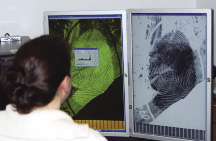 |
| A latent print examiner uses the Latent Print Digital Imaging System to improve the quality of a latent fingerprint submitted to the Laboratory. |
The Latent Print Digital Imaging System (LPDIS) is a state-of-the-art suite of hardware and software that can digitally improve the visual appearance of latent and known print images. The LPDIS has broadened the Laboratory’s ability to identify previously unusable latent prints and has increased the ability to conduct searches of the IAFIS databases, which include the prints of more than 60 million individuals. Image quality plays a critical role in generating IAFIS matches; using the LPDIS to improve the visual appearance of poor-quality latent and known prints has resulted in more leads for field investigators. Also, because of its effectiveness, the LPDIS has become a major factor in the exchange of latent and known images between the military in Iraq and Afghanistan, the Terrorist Explosive Device Analysis Center (TEDAC), and the U.S. government’s international partners. The TEDAC has increasingly relied on digital imaging as a means of handling latent prints developed on improvised explosive devices. As a result, the LPDIS is an important part of the war on terror.
Questioned Documents Unit
The Questioned Documents Unit (QDU) provides forensic support to federal, state, and local law enforcement agencies by conducting forensic examinations on evidence collected during investigations. These include examinations of handwriting, typewriting, shoe prints, tire treads, alterations, obliterations, rubber stamps, plastic bags, and reconstructed shredded paper. The unit also provides training and field support to the FBI and federal, state, and local law enforcement.
MatchMaker
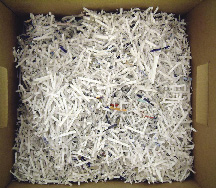 |
|
| Box of shredded paper prior to separation and reassembly |
Reassembly using MatchMaker |
MatchMaker is a computer-assisted reconstruction system used to facilitate the reassembly of cross-cut shredded documents. A basic version of MatchMaker was brought online in January 2007 and already has significantly improved the speed of information recovery in cases involving shredded paper and saved the FBI considerable labor costs in the process.
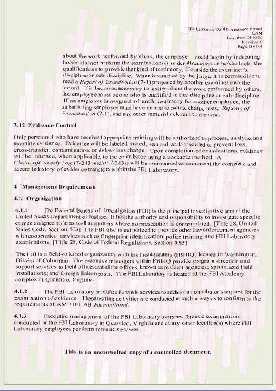 |
| Product reassembled with MatchMaker |
A typical commercially available cross-cut shredder renders an 8 1/2- by 11-inch sheet of paper into approximately 400 to 600 paper fragments. The document examiner then must reconstruct these paper puzzles into readable documents. Prior to the development of MatchMaker, these cases were completed manually, consuming countless work hours and diminishing the value of the information even when the documents were reconstructed. Manual reconstruction of one sheet of paper would take the document examiner approximately one week.
Reconstruction time has substantially improved with the use of MatchMaker. In 2007 MatchMaker was used to reconstruct 50 pages of cross-cut shredded documents consisting of 7000 fragments. Reconstructing these documents manually would have taken approximately one year, but using the MatchMaker system, the job was completed in only two months.
The final electronically reconstructed document can be printed and sent to the investigator at a fraction of the time and cost of previous techniques. In addition to performing the reconstruction, the system records case statistics, enabling management to track reassembly information.
Continued development of the system will ensure that larger cases can be handled by the system with enhanced algorithms that will further speed reconstruction.
Chemistry Unit
The Chemistry Unit is composed of five subunits: General Chemistry, Paints and Polymers, Toxicology, Metallurgy, and Instrument Operation and Support. The personnel in each subunit have specialized, formal education, training, and experience and examine such evidence as writing inks, lubricants, self-defense sprays, general chemical unknowns, paint, adhesives, tapes, dyes from bank security devices, metals for elemental composition, materials for failure analysis, biological specimens for drugs and poisons, and commercial products for evidence of tampering. Approximately $6 million worth of analytical instrumentation allows the unit to provide this wide range of services to its customers and support the missions of the Laboratory and the FBI.
Forensic Paint and Glass Examinations
In support of and in preparation for the International Criminal Police Organization (INTERPOL) International Forensic Science Symposium held every three years, FBI Laboratory personnel were responsible for writing a review of advancements and research studies on topics of interest in forensic paint and glass examinations over the period from 2004 through 2007. A presentation of this review was given at the INTERPOL symposium held in October 2007 in Lyon, France. The INTERPOL symposium provides a forum for managers of forensic laboratories to exchange information, discuss issues facing forensic laboratories and forensic science, and receive updates about different types of forensic examinations and evidence since the last meeting. Fire debris, toolmarks, DNA, impression evidence, and digital evidence are just a few examples of other topics that were presented.
In addition to the presentations given at the symposium, reviews of the advancements in each discipline were written and compiled into one document, which is available on the INTERPOL Web site at http://www.interpol.int/public/Forensic/IFSS/Default.asp.
The National Automotive Paint File
The Chemistry Unit houses and maintains the National Automotive Paint File (NAPF), a reference collection of automotive paint-color panels that can be searched by make, model, and year (MMY) to assist in identifying vehicles involved in crimes. These color panels represent vehicles manufactured for sale in North America. Each year, automotive manufacturers send newly introduced colors to the FBI Laboratory via a color-standard panel.
The FBI Laboratory also uses a second database, the Paint Data Query (PDQ), in MMY searches. Unlike the NAPF database, the PDQ uses the layer structure (number of layers, color of each layer, and order in which they are applied) and the chemical composition of the individual layers of paint on a factory-applied automotive finish.
The Royal Canadian Mounted Police (RCMP) maintains the PDQ. In recent years, the RCMP has expanded the database beyond the North American market to include Japan and the European Union. As part of this effort, the laboratory of the Federal Criminal Police Office (Bundeskriminalamt, BKA), in Wiesbaden, Germany, has sent thousands of panels from the European Collection of Automotive Paints (EUCAP) to the RCMP for inclusion in the PDQ.
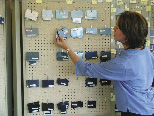 |
| A forensic examiner in the Laboratory’s Chemistry Unit searches the paint panels of the National Automotive Paint File; the panels are cataloged according to their color. |
A recent inventory of the NAPF found that the collection was incomplete for a number of automobile manufacturers. The RCMP agreed to send the EUCAP panels to the FBI Laboratory in order to fill the gaps identified in the NAPF.
At this writing, more than 400 of the panels supplied by the BKA have filled gaps in the NAPF. For example, prior to adding the EUCAP panels, only 76 percent of the colors available on North American Audi vehicles were present in the NAPF. With the EUCAP panels, 97 percent of the North American Audi colors are now represented. This collaborative effort means that fewer suspects will get away with their crimes.
A Completely Automated Method for Analyzing Cocaine and Metabolites in Urine and Blood
Worldwide, cocaine is the most widely abused recreational drug and thus is commonly encountered in many forensic and clinical toxicology cases. Cocaine is extensively metabolized, forming the metabolites benzoylecgonine, ecgonine methyl ester, and ecgonine. Additionally, when cocaine is ingested with ethanol, cocaethylene is produced. This metabolite causes intensified euphoric effects but is also highly toxic. Most toxicology laboratories employ immunoassay screening followed by confirmation with off-line solid-phase extraction (SPE) and gas chromatography-mass spectrometry (GC-MS). As laboratories are constantly called upon to develop new, fast, and inexpensive methods, the Chemistry Unit of the FBI Laboratory has now developed a new, completely automated method for the analysis of cocaine and its major metabolites.
This automated method is unique in that it interfaces an in-line extraction liquid chromatography (LC) system with a very sensitive tandem mass spectrometer (MS/MS) so that these two instruments function as a single unified system. The in-line extraction system consists of a storage compartment, autosampler, two pumps, and an extraction unit. This system allows direct extraction, chromatographic separation, and mass spectral identification, bypassing the need for the timely and costly manual extraction techniques typically used on blood and urine samples. Using this combined system, the Chemistry Unit developed a method to analyze cocaine, benzoylecgonine, cocaethylene, ecgonine methyl ester, and ecgonine in urine and blood. Based on the current literature, this is the first fully automated SPE-LC-MS/MS method for detecting cocaine and its major metabolites in a single analysis.
Sensitive Test Detects Toxin
In July 2006 Kathy Augustine, a local politician in Nevada, died under suspicious circumstances. The local medical examiner could not determine Augustine’s cause of death. Chaz Higgs—Augustine’s husband and a nurse—was reported to have told a colleague that the best way to kill someone was with a drug known as succinylcholine, because it was undetectable. Because the local laboratory in Nevada did not have the instrumentation needed to test for succinylcholine, the FBI Laboratory was asked to assist in the investigation. Analysis identified succinylcholine, a paralytic agent, and its metabolite in Augustine’s urine. Following the release of the FBI Laboratory’s toxicology report, Higgs was charged with homicide. He was tried by the State of Nevada in June 2007. The testimony of an FBI Laboratory toxicologist was the key in the presentation of the State’s case. A jury of Higgs’ peers found him guilty, and he was sentenced to life in prison.
Combined DNA Index System Unit
Eighty-year-old Alice Virginia Mosconi was bludgeoned to death in her home in Verdi, Nevada, in June 2001. Her case remained unsolved until October 2005, when DNA found on a pair of panty hose linked Joaquin B. Hill, also known as Kiven Johnson, to her slaying. Hill was an inmate in a California prison serving a nine-year sentence on stolen vehicle and drug charges when the DNA database hit occurred. For years, the Mosconi family had worked to keep their mother’s case alive. They were very happy when notified that a suspect had been positively identified. Five years after Virginia’s murder, Hill was sentenced to two life sentences without parole. Thanks to the Combined DNA Index System (CODIS), DNA evidence identified Virginia’s killer when she could not.
The FBI Laboratory’s CODIS Unit directs both the CODIS Program and the National DNA Index System (NDIS). The CODIS Program allows forensic DNA laboratories to store, maintain, and search DNA profiles from crime scenes, offenders, and missing persons. The CODIS Unit provides to partner agencies the CODIS software, as well as enhancements, support, training, help-desk services, and biannual national meetings for CODIS administrators. International law enforcement laboratories also receive CODIS software to assist with establishing a DNA database program. Forty-two law enforcement laboratories in 28 countries now have the CODIS software.
CODIS’ three-tiered hierarchy of databases includes NDIS, which is the highest, followed by the State DNA Index System (SDIS) and the Local DNA Index System (LDIS). There are currently 178 NDIS-participating sites consisting of 126 local laboratories and 52 state laboratories, including the FBI Laboratory and the U.S. Army Criminal Investigation Laboratory. NDIS contains DNA profiles contributed by participating federal, state, and local forensic DNA laboratories and currently contains more than 5 million profiles of samples taken from offenders, crime scenes, and missing persons.
The success of CODIS depends on maintaining a database of a state’s offender profiles and using it to solve crimes for which there are no suspects. Today all 50 states have laws requiring that offenders convicted of sexual offenses and other violent crimes provide DNA samples. These DNA samples are analyzed and entered into the state and national DNA databases.
CODIS uses several indexes to generate investigative leads in cases where biological evidence is recovered from the crime scene. The Convicted Offender Index contains profiles of individuals convicted of felony offenses and other crimes. Some states have an Arrestee Index that contains profiles from persons arrested for certain crimes. The Forensic Index contains DNA profiles developed from crime scene evidence, such as semen stains and blood. There are also three missing-person-related indexes. The Relatives of Missing Persons Index contains DNA samples voluntarily contributed from the relatives of missing persons that are searched against samples in the Unidentified Human Remains Index and the Missing Persons Index.
When a DNA profile is developed from crime scene evidence, the laboratory searches the DNA profile against the Forensic and Convicted Offender Indexes. If a match occurs with the Convicted Offender Index, the laboratory will confirm the sample and release the identity of the suspected perpetrator. If a match occurs with the Forensic Index, the laboratory has linked two or more crimes, and the law enforcement agencies involved in the cases can pool investigative information and resources.
The charts below depict the statistics tallied by CODIS through the 2007 calendar year.
| CODIS Statistics Through 2007 |
| Category |
Total Number |
| Investigations Aided |
62,059 |
| Forensic Index Hits |
11,750 |
| Offender Index Hits |
49,813 (43,305 at SDIS and 6,508 at NDIS) |
| NDIS Statistics Through 2007 |
| Category |
Total Samples |
| Offender Index |
5,372,773 |
| Forensic Index |
203,401 |
| Participants |
| Domestic Laboratories |
178 state and local laboratories plus NDIS |
| International Laboratories |
42 laboratories in 28 countries |
| Training |
1,311 individuals in more than 222 laboratories have received CODIS training. |
| CODIS Statistics 2001-2007 |
| |
2001 |
2002 |
2003 |
2004 |
2005 |
2006 |
2007 |
| Offender Profiles |
750,929 |
1,247,163 |
1,493,536 |
2,038,514 |
2,826,505 |
3,977,433 |
5,372,773 |
| Forensic Profiles |
27,897 |
46,177 |
70,931 |
93,956 |
126,315 |
160,582 |
203,401 |
| |
|
|
|
|
|
|
|
| Investigations Aided |
3,635 |
6,670 |
11,220 |
20,792 |
30,455 |
43,156 |
62,059 |
| Forensic Hits |
1,031 |
1,832 |
3,004 |
5,147 |
7,071 |
9,529 |
11,750 |
| Offender Hits Total |
2,371 |
5,032 |
8,269 |
13,855 |
21,519 |
32,439 |
49,813 |
| National |
167 |
638 |
1,151 |
1,864 |
2,855 |
4,276 |
43,305 |
| State |
2,204 |
4,394 |
7,118 |
11,991 |
18,664 |
28,163 |
6,508 |
DNA Analysis Unit-1
The DNA Analysis Unit-1 (DNAAU-1) provides serological and nuclear DNA testing services to support criminal and counterterrorism investigations, the Federal Convicted Offender Program, and the National Missing Person Database Program. The unit also provides expert witness testimony in criminal judicial proceedings on both a national and international level.
Serological analysis involves the examination of evidentiary items to detect and identify biological fluid stains, such as from blood and semen. This testing facilitates the determination of stains that may be suitable for DNA testing. Nearly all biological materials contain DNA. Thus, evidentiary items such as cigarette butts, drinking vessels, envelopes, and clothing are other potential sources of DNA. DNA profiles obtained from evidentiary items are compared to DNA profiles obtained from known individuals. The power of the testing done by the DNAAU-1 lies in its ability to potentially identify an individual as the source of the DNA obtained from an evidence item to a reasonable degree of scientific certainty, as well as to definitively exclude an individual as being the source of the DNA. Where appropriate, the DNA-typing results from evidence items examined in the DNAAU-1 are uploaded into the NDIS to enable nationwide comparison of DNA profiles among law enforcement agencies. Such comparison aids investigations by identifying potential perpetrators or linking serial violent crimes. In fiscal year (FY) 2007 (October 2006–September 2007), DNAAU-1 received 1620 evidence submissions and completed work on 1574 cases. DNAAU-1 examiners provided expert witness testimony in 36 criminal trials.
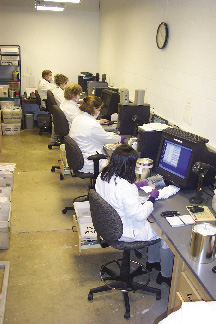 |
| Biologists in the Federal Convicted Offender Program check in convicted offender blood samples prior to DNA testing. |
The DNAAU-1 Federal Convicted Offender (FCO) Program uses nuclear DNA profiling techniques to type known samples from federal convicted offenders and federal arrestees, which are entered into NDIS. Comparison of these DNA profiles with those from forensic samples maintained in NDIS may effectively identify to investigators potential unknown perpetrators of unsolved crimes. Since the FCO Program’s inception in June 2001, more than 226,000 samples have been received from more than 500 collection sites, with a current average of 6500 samples received per month. In FY 2007 alone, 79,325 samples were received, 23,341 convicted offender profiles were completed, and 113 hits were generated between convicted offender DNA profiles and forensic DNA profiles. The implementation of high-throughput robotics and sample-tracking software has significantly increased the number of DNA profiles generated for NDIS entry and thus increased the potential number of investigations aided through DNA database hits. In addition, this high-throughput capacity serves other investigational areas such as mass disasters and body identifications to support intelligence-based applications. An emerging demand also has been identified regarding missing-person investigations. The DNAAU-1 supports the National Missing Person DNA Database Program by conducting nuclear DNA analyses of unidentified human remains, as well as reference samples of missing persons and their biological relatives. In FY 2007, evidence from more than 250 missing-person cases was submitted to the DNAAU-1.
In FY 2007, DNAAU-1 personnel provided training to 3400 law enforcement and forensic laboratory personnel at 50 training sessions, seminars, conferences, and scientific working group meetings. Additionally, more than 440 members of the forensic DNA community received DNA auditor instruction from DNAAU-1 personnel on the quality assurance standards for DNA testing laboratories and convicted offender DNA databasing laboratories.
Civil Rights Investigation in Virginia
 |
| A DNAAU-1 biologist prepares samples for robotic DNA processing. |
In 2004, members of the South Nazarene Church in Chesterfield, Virginia, began receiving threatening letters containing racial slurs aimed at church member and custodian Franz Cadet. Some of the letters contained threats to kill Cadet, whose vehicle had been stolen and was later found to have been destroyed by fire. Members of the church provided Cadet with a new vehicle. In fact, the congregation provided substantial monetary aid as well as numerous products and services to assist him and his family through a multitude of financial, physical, and legal crises. Cadet named several individuals who he believed could be the source of the threats: women with whom he had had extramarital affairs, as well as a former coworker who had filed a sexual harassment suit against him. Cadet and his wife complied with a request to provide buccal (cheek) samples to serve as references for DNA analysis. More than 100 envelopes, each having moisture-activated flaps, also were submitted to the Laboratory. DNA analysis revealed that Cadet himself was the source of the DNA on several envelopes, suggesting that he had carried out the threats against himself in order to gain the sympathy and financial aid of fellow church members. The DNA recovered from some of the envelope flaps was consistent with that of the biological children of Cadet and his wife, suggesting that Cadet had also enlisted his children in the scam.
Uncovered Evidence Links Convicted Offender to Several Bank Robberies
 |
| A biologist assigned to the Federal Convicted Offender Program checks in blood samples collected from convicted offenders for registry in the National DNA Index System. |
Two armed men entered the BB&T Bank in Gainesville, Virginia, and ordered everyone to the ground at gunpoint. Within five minutes, the men had obtained substantial sums of cash and departed the bank in a van that had been stolen in Alexandria, Virginia. Two years after the robbery, a pair of black goggles, similar to those worn by one of the perpetrators during the robbery, was uncovered during an evidentiary inventory. The goggles were submitted to the Laboratory, and a complete DNA profile of the wearer of the goggles was obtained. After the DNA profile was entered into the National DNA Index System, a hit was returned, linking the DNA profile from the goggles to that of a convicted offender sample within the FBI’s Federal Convicted Offender Database. The hit was confirmed within days, and the name of the offender was provided to the FBI’s Washington Field Office. The bank robber was linked to at least 10 other bank robberies in the Northern Virginia area and possibly three others in Montgomery and Calvert County, Maryland.
Six Members of an International Kidnapping Ring Brought to Justice
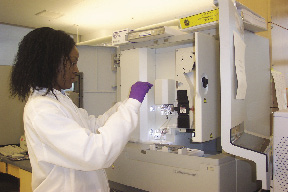 |
| A DNAAU-1 biologist injects a reagent into an analytical instrument. |
The FBI’s Los Angeles and New York dive teams recovered four bodies from a reservoir located about 500 miles north of Los Angeles. An additional body, which had been recovered by the local sheriff’s department, was linked to the same crime. All were identified as Russian businessmen or their associates, who had been kidnapped for ransom or used to lure other targets. Regardless of whether the ransom had been paid, the victims were gagged, their hands and feet bound, and their bodies weighted down with weight plates before being dumped into the reservoir. Investigation led to a Russian international kidnapping ring, and six subjects were charged with hostage taking resulting in the deaths of five people.
Serological and nuclear DNA examinations were conducted on approximately 65 items of evidence. DNA recovered from bloodstains from a bridge near the reservoir and from two different pairs of handcuffs matched the victims. Additional handcuffs yielded DNA that did not match the victims, suggesting that there are other unknown victims. Furthermore, DNA profiles developed from several cigarette butts linked the defendants to relevant locales.
Three defendants pleaded guilty to federal and state charges and cooperated with the government during the trial. A fourth defendant was sentenced to life in prison without the possibility of release. Following a 10-hour jury deliberation, the two ring leaders were sentenced to death.
The judge commented that this was the most compelling case he had ever witnessed in 30 years on the bench and that, in his opinion, the case was proven “beyond all possible doubt.” The federal death-penalty verdicts were the first handed out in California since the post-World War II era.
DNA Analysis Unit-2
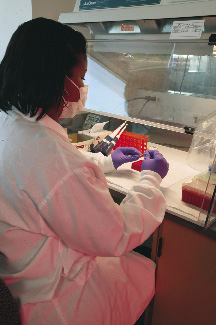 |
| A DNAAU-2 biologist grinds hair for mitochondrial DNA extraction. |
Mitochondrial DNA (mtDNA) is typically found in such evidence as naturally shed hairs, hair fragments, bones, and teeth, which contain minute amounts of degraded DNA. With its high sensitivity, mtDNA analysis allows personnel in the DNA Analysis Unit-2 (DNAAU-2) to obtain information from items of evidence with little biological material, as well as old evidence from cold cases and highly degraded samples from mass disasters. Although unique identifications are not possible using mtDNA, the ability to associate an mtDNA profile with the maternal relative of an individual can narrow down the pool of possible candidates and increase the odds of identifying the source of the DNA. Mitochondrial DNA samples are also uploaded into the CODIS database.
Suspected Atlanta Child Killer Revealed
In 1982, Wayne Williams was convicted for the murders of two men. At the trial, evidence from 10 other murders was also introduced, although charges for these killings were never filed. Following his conviction, Williams was widely believed to be the Atlanta child killer responsible for the slaying of 29 children and young adults between 1979 and 1981, even though Williams has always maintained his innocence. Hoping for a retrial for the 1982 convictions, in January 2007, Williams’ lawyer requested DNA testing of the hairs in the case. The court granted the request, based on a Georgia statute allowing postconviction testing using technology not available at the time of the trial.
Patrick Baltazar was an 11-year-old boy who disappeared in 1981. His body was found a few days later, an apparent victim of the Atlanta child killer. Three hairs recovered from Baltazar’s body were examined microscopically and found to match Williams’. The microscopic comparison of these hairs had been presented in the 1982 trial. Mitochondrial DNA analysis of these hairs was part of the requested postconviction testing.
The hairs were submitted to the FBI Laboratory in 2007, and one was selected for mtDNA analysis. The comparison of the mtDNA sequences from the hair and the saliva sample taken from Wayne Williams determined that Williams could not be excluded as the source of the hair. Although he was never charged with the additional murders, the DNA results prevented him from receiving a new trial for the 1982 convictions.
Improving DNA Analysis Methods
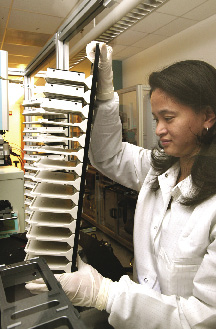 |
| A contractor assigned to the Terrorist Explosive Device Analytical Center loads sample plates into the mass spectrometer. |
In an effort to improve the analysis of evidence in support of the mission of the Terrorist Explosive Device Analytical Center, DNAAU-2 is validating an innovative method for analyzing mtDNA through base-composition analysis by mass spectrometry. Mass spectrometry is a quantitative method based on the separation of ionized particles according to the intrinsic mass-to-charge (m/z) ratio. Based on this information, the mass of the ionized particles can be determined.
For mtDNA examinations, fragments of mtDNA are ionized and detected. The weight of these fragments is calculated and a list of possible base compositions is derived, with an overall base- composition profile being determined for each double-stranded mtDNA fragment. Because each ionized particle is detected independently, base-composition analysis is capable of detecting and resolving mixtures of mtDNA types. Using the current sequencing method, mixtures of mtDNA types are uninterpretable. Base-composition analysis uses robotics, resulting in a highly automated, high-throughput process capable of generating large volumes of data with minimal manual operation. This method will allow DNAAU-2 to analyze new evidence types, obtain results from challenging samples, and rapidly generate high-quality data.
The National Missing Person DNA Database Program
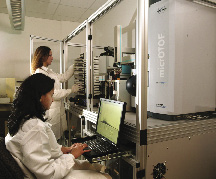 |
| Contractors assigned to the Terrorist Explosive Device Analytical Center prepare sample plates for mass spectrometry analysis. |
In 2000, the Laboratory began developing the National Missing Person DNA Database (NMPDD) Program for the identification of missing and unidentified persons using CODIS. The NMPDD contains three indexes in which missing- and unidentified-person DNA profiles can be entered: Biological Relatives of Missing Persons, Unidentified Human Remains, and Missing Persons.
In the FBI Laboratory, the DNAAU-1 (which analyzes nuclear DNA) and DNAAU-2 (which analyzes mitochondrial DNA) perform DNA analysis on samples from unidentified human remains and biological relatives of missing persons. The NMPDD provides investigators with an opportunity to identify missing and unidentified persons on a national level.
Since 2000, the DNAAU-2 has completed 1590 missing-person cases submitted by local, state, and federal agencies. There have been 190 mitochondrial DNA associations for unidentified human remains samples and samples from biological relatives of missing persons. In 2007, 383 cases were submitted to the NMPDD for analysis, and the DNAAU-2 processed 461 cases for mitochondrial DNA analysis.
 |
| A DNAAU-2 biologist assigned to the National Missing Person DNA Database Program photographs a human femur prior to mitochondrial DNA extraction. |
In addition to processing cases, in 2007, members of the NMPDD were active in educating the forensic and law enforcement communities about the value of the program to investigators of missing-person cases. Presentations detailing the purpose of the program and submission guidelines were provided to various local, state, and federal agencies and organizations. The NMPDD has participated with the National Institute of Justice in a number of workshops and meetings concerning the identification of missing persons. These meetings provide information to assist law enforcement, forensic scientists, coroners, medical examiners, and the relatives of missing family members.
A Tooth Reveals the Truth
In June 2004, human body parts were found in the trunk of a vehicle that had been abandoned and seized after a police pursuit in Fairbanks, Alaska. The remains were believed to be those of David J. Mason. A dental examination was inconclusive, and the state crime laboratory was unable to obtain a nuclear DNA profile from the degraded remains. In August 2004, a tooth was sent to the FBI Laboratory for mitochondrial DNA analysis. Because Mason had previously served in the military, a sample of his blood was housed in the Armed Forces DNA Repository of the Armed Forces Institute of Pathology. The mtDNA sequence from the tooth was compared to the mtDNA sequence from Mason’s blood sample. The mtDNA sequences were concordant, so Mason could not be excluded as the source of the human remains recovered in the trunk of the vehicle.
An investigation by the Alaska State Police developed Jason S. Fisher as the prime suspect, and in October 2005, Fisher was apprehended and charged with Mason’s murder. On November 5, 2007, he pleaded guilty. This case illustrates how cooperation between federal agencies can assist coroners, medical examiners, and law enforcement agencies in determining the identity of unidentified human remains and bringing closure to family members.
Regional Mitochondrial Laboratories Up and Running
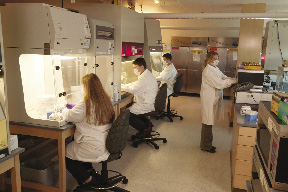 |
| DNAAU-2 biologists conduct examinations for Indian Country, the National Missing Person DNA Database Program, the Terrorist Explosive Device Analytical Center, and other cases. |
Four regional crime laboratories partnered with the FBI Laboratory in 2003 to augment the nation’s capacity to perform mtDNA analysis in forensic and missing-person cases. This analysis is conducted free for state and local law enforcement agencies. Partner laboratories are responsible for mtDNA and hair analysis, reporting results, and testifying, if necessary.
By 2007, all four regional laboratories—the Arizona Department of Public Safety Central Crime Laboratory in Phoenix, the Connecticut Department of Public Safety Forensic Science Laboratory in Meriden, the Minnesota Bureau of Criminal Apprehension Forensic Science Laboratory in St. Paul, and the New Jersey State Police Office of Forensic Sciences in Hamilton—had been approved to upload mtDNA profiles into the National Missing Person DNA Database. This database is an increasingly valuable resource with the potential to identify missing persons by linking them to DNA profiles of relatives or unidentified human remains.
Since the regional laboratories began accepting casework in late 2005, more than 550 cases have been assigned to them. The work they provide has developed investigative leads for local law enforcement and aided in the identification of unidentified human remains. The ability of the regional laboratories to conduct analysis on this number of cases has enabled the FBI Laboratory to significantly decrease turnaround time in both criminal and missing-person mtDNA cases, providing additional benefits to local law enforcement. The first testimony by a regional laboratory analyst took place in New Hampshire in 2006, and since then, testimony has been given more than 20 times in cases across the United States.
The FBI Laboratory remains committed to building long-term partnerships with state and local forensic laboratories to provide critical forensic services as well as to develop and implement new technologies. The FBI and the criminal justice community continue to benefit from the work of the talented and dedicated employees from these regional crime laboratories as well as from international, national, state, and local laboratories.
Trace Evidence Unit
The Trace Evidence Unit (TEU) identifies and compares specific types of trace materials that can be transferred during a crime. The collection of these evidentiary materials is typically conducted by Evidence Response Team personnel for FBI cases or by the state or local law enforcement agency submitting the case to the Laboratory. The types of materials that are routinely analyzed and compared in the TEU are hairs, fibers, fabric, cordage, soil, glass, building materials, gemstones, feathers, and wood. The physical contact between two people or between a person and an object can result in the transfer of these materials. The analysis and comparison of these materials often can link a suspect to a victim or a crime scene. In addition, the TEU provides scientific examinations in the area of forensic anthropology.
 |
 |
 |
 |
| Feather examination
|
Wood examination |
Wood microstucture |
Dyed animal hair |
After analyzing evidence submissions, TEU examiners issue a report, which is the mechanism to disseminate the scientific results to the contributor. In 2007 the TEU completed analysis on approximately 10,000 items of evidence in 2300 cases. Approximately 1300 of these cases involved improvised explosive devices examined for hairs and fibers in support of the Terrorist Explosive Device Analytical Center.
Other significant aspects of the TEU’s mission are testifying in legal proceedings on the results of its examinations, training members of the law enforcement community, providing forensic field support in FBI cases, and developing and implementing new technologies to enhance scientific examinations. To support the Laboratory’s training mission, the TEU sponsored or participated in numerous ventures. One- to two-week courses were given in the areas of hair and fiber examinations and Indian Country Crime Scene Analysis to audiences in Montana, Arizona, Colorado, and Oklahoma and at the FBI Academy in Quantico. In support of the Regional Mitochondrial DNA Laboratory initiative, the TEU trained two hair examiners who will work in two of these regional laboratories.
Trace Evidence Symposium
In August 2007 the FBI Laboratory and the U.S. Department of Justice’s National Institute of Justice cosponsored a Trace Evidence Symposium. The purpose of the symposium was to foster increased awareness among forensic scientists, law enforcement, and the legal community on the value of trace evidence. It had been more than 10 years since the last trace evidence symposium had been conducted. This symposium served as an educational forum for trace evidence examiners as well as an avenue to identify new areas of research and technological needs within the various subdisciplines of trace evidence.
 |
| Glass examination |
Trace evidence is considered one of the most diverse of the forensic disciplines because it can include the analysis of hair, fiber, paint, glass, soil, and other particulate matter using a variety of microscopes and analytical instrumentation. Because of the diverse nature of this field, the symposium represented a broad range of issues, from technological foundations and research methods to applied practices and policy considerations that impact the field of trace evidence analysis. Papers presented at the symposium included such topics as elemental analysis of glass, fiber transfer and persistence, paint analysis in graffiti cases, admissibility issues such as Daubert, and the role of establishing probative value to trace evidence. Workshops focused on more in-depth analysis and interpretation of such techniques as feather identification, microspectrophotometry, Fourier transform infrared spectroscopy, and elemental analysis, as well as other instrumental analysis methods.
 |
| Fiber under polarized light |
The symposium was a tremendous success, with more than 300 people from 17 countries attending. The attendees had diverse backgrounds and included personnel from forensic and nonforensic laboratories, universities, private companies, and the legal community. In addition to the educational opportunity provided, the symposium gave participants a chance to build relationships with members of all of these groups, which can only serve to both strengthen the trace evidence community and foster new developments for the future.
Operational Support Branch
The units assigned to the Laboratory’s Operational Support Branch (OSB) conduct a wide range of activities that directly support the FBI’s mission and the core functions of collection, information dissemination and integration, analysis, and action. Operational Response Section units—including the Chemical-Biological Sciences Unit, the Evidence Response Team Unit, the Hazardous Materials Response Team Unit, and the Photographic Operations and Imaging Services Unit—must be ready at a moment’s notice to respond to crimes, mass disasters, special events, and other incidents anywhere in the world. They bring critical federal resources and coordinate the response of FBI field office teams to work with local officials on the scene.
The Forensic Science Support Section provides mission-critical services in support of all FBI Laboratory units. The Planning and Budget unit manages the Laboratory’s budget and equipment, and the Administrative Unit provides administrative and human resource support. Research and development efforts generate from the Counterterrorism and Forensic Science Research Unit. The IT Coordination Group helps to improve Laboratory processes with its innovative program, INNOVARi. Special Projects Unit personnel conduct a range of activities, including creating physical and virtual models for forensic investigations and prosecutions, documenting crime scenes and special-event venues, creating forensic facial images and composite drawings, and designing Laboratory publications. The Security Team maintains the safety and security of the Laboratory’s premises, personnel, and information.
Security Team
The Security Team has a significant role in maintaining the security of the Laboratory’s premises, personnel, and information. These duties encompass all security-related issues, such as facilitating access to Laboratory and sensitive compartmented information and facilities; conducting personnel security briefings, debriefings, interviews, and five-year reinvestigations; and ensuring compliance with security policies and procedures.
In 2007 the Security Team oversaw the installation of a new access-control system to enhance security at the Laboratory’s front door and eliminate the need for an extra badge that all Laboratory employees had formerly been issued. Security personnel also assisted in the accreditation of three new facilities for specialized work being conducted by the Hazardous Materials Response Unit, the Evidence Response Team Unit, and the Chemical-Biological Sciences Unit. Finally, the Security Team rewrote the standard of operation for FBI police officers at the Laboratory to incorporate changes to the Laboratory’s security policy.
Administrative Unit
The mission of the Administrative Unit (AU) is to provide administrative and human resource services to the Laboratory by coordinating, directing, and facilitating various programs and initiatives in the areas of personnel, staffing matters, and mail services to ensure Division-wide compliance with FBI policies, procedures, and guidelines. The unit also researches, plans, and implements various initiatives as assigned by Division executive management to support not only the Laboratory’s mission but also the FBI’s overall mission. The AU had several major accomplishments in 2007.
The Laboratory could not support the FBI’s mission without a qualified staff, and the AU plays an important role in maintaining that staff. AU staff members represent an integral link between the Laboratory and the FBI’s Human Resources Division and Resource Planning Office for all staffing matters. Through this working relationship, the AU facilitated numerous job-posting requests during the year. In addition, the AU was instrumental in recommending and receiving approval from the Resource Management and Allocation Committee to implement new procedures to streamline the promotion process for examiners in several Laboratory units. These new procedures allow qualified examiners to be promoted without using the posting process, which enhances the Laboratory’s ability to fill these specialized positions more effectively.
 |
| Administrative Unit staff members coordinate and process numerous personnel matters for approximately 550 Laboratory employees. |
The AU also oversees several additional programs to help recruit qualified candidates. The Cooperative (Co-Op) Education Program was created to develop long-term, proactive relationships with colleges and universities to attract and recruit highly qualified candidates to assist and support the Laboratory in specific disciplines or skill-set areas. The Co-Op program provides students with meaningful work while creating a diverse pool of qualified applicants who require less training and have higher retention rates than other new hires. The student receives competitive compensation while applying classroom knowledge and refining career goals. At the same time, the university enhances its relationship with the FBI while providing students with a well-rounded educational experience. In 2007 the Laboratory coordinated with the FBI’s Operational Technology Division (OTD) to transfer a Co-Op chemist from the OTD to the Laboratory’s Counterterrorism and Forensic Science Research Unit (CFSRU).
In addition, AU personnel coordinated with the FBI’s Human Resource Division to place 26 interns participating in the FBI’s Honors Internship Program (HIP) and 2 interns for the Volunteer Internship Program (VIP). The HIP is a summer program that offers interns a 10-week view of FBI operations and provides them an opportunity to explore the many career opportunities within the organization. The interns work on important research projects to help the Laboratory and the FBI achieve their missions.
VIP participants are not considered FBI employees but rather serve as volunteers, participating in the program during the school year, summer break, or school vacation periods. VIP interns support the office without counting against funding staffing levels.
AU staff also respond to numerous work-life issues, such as leave without pay, maternity leave, compensatory time, work-at-home options, and alternate work schedules. In 2007, at the direction of Laboratory executive management, the AU created a new work-life policy, which recognizes the changing demographics of the workforce. Through the flexible work options set out in the new policy, the Division strives to balance the personal needs of its employees with the requirements of the Laboratory’s mission.
 |
| Mail Room employees must X-ray all packages received in the Laboratory and remain alert for potentially dangerous or hazardous materials. |
For nearly 100 years, FBI employees have recorded their time and attendance on paper. Different types of leave were recorded using different colored pencils. In 2007, the FBI reached a milestone when it instituted the Web-Based Time and Attendance (WebTA) system. Through this easy-to-use, intranet-based system, employees enter their own time and attendance, eliminating the need for paper records, repetitive data entry, and signing in and out every day. AU staff members coordinated this initative and serve as points of contact for the Division.
The AU also manages many Division programs that contribute to the overall mission of the Laboratory. These programs include equal employment opportunity, employee assistance, upward mobility, ethics, fleet management, and employee suggestions. The Mail Services Group is an integral part of the unit, providing full-service, in-house mail and shipping services for the entire Division and handling more than 80,000 incoming and outgoing shipments of mail, supplies, equipment, and other deliveries in 2007.
Counterterrorism and Forensic Science Research Unit
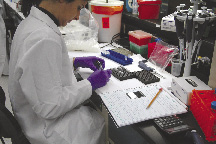 |
| The CFSRU conducts innovative scientific research, developing new methods and technologies to support the needs of the Laboratory’s operational units. |
The Counterterrorism and Forensic Science Research Unit (CFSRU) provides the FBI Laboratory’s foundation for innovative scientific research and development designed to support FBI operations. To maximize resources and capabilities, the CFSRU teams with academia and other government agencies for a synergistic approach to a common mission: to advance forensic science and combat terrorism. Collaborative efforts with other government agencies enable CFSRU personnel to successfully research, develop, and deliver new technologies and methodologies to operational units within the FBI Laboratory.
The research program within the CFSRU is guided by the Laboratory’s newly established Research Council (RC), which provides oversight and monitors the performance of the Laboratory’s research and development efforts. Chartered in October 2006, the RC consists of Laboratory executive management and senior scientists as voting members. The RC evaluates, selects, prioritizes, and recommends research projects to include in the Laboratory’s research portfolio and ensures that research investments are aligned with the Laboratory’s strategic goals and objectives. During its first year, the RC focused on improving the alignment of existing resources with active research that meets the needs of the Laboratory. Projects that had advanced beyond the stage of novel research were transferred from the CFSRU to operational units for validation prior to implementation. This enabled the CFSRU to reduce the number of active projects and focus on technical research to meet the continually advancing needs of the Laboratory.
 |
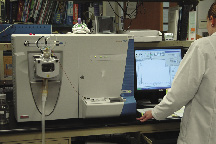 |
| Bacteria incubated in a fermentor are used to study characteristics resulting from variations in growth substrates and methods that could potentially be used in the production of bacterial threat agents. |
Research conducted to develop new methods for the chromatographic separation and identification of proteins will advance the Laboratory’s future capabilities to analyze evidence. |
In 2007, CFSRU personnel, together with participants in the Visiting Scientist Program, executed more than 100 research and development projects, presented findings at numerous national and international technical conferences, and submitted eight manuscripts for publication in peer-reviewed scientific journals. CFSRU scientists are the leading experts in their respective fields and provide valuable advice and guidance to both the FBI and other law enforcement agencies as requested. In addition to its role in research and development, the CFSRU provides advanced scientific training to Laboratory personnel and scientists from other federal, state, and local law enforcement agencies. Specialized forensic classes range from one-day workshops to weeklong classes with both interactive lectures and hands-on laboratory exercises. In 2007, the CFSRU provided specialized training in such subjects as glass analysis, handwriting examination, human identification through DNA analysis, infrared spectrometry, mass spectrometry, and introduction to instrumental analysis.
FLASH ID: Evaluating the Individuality of Handwriting
Forensic document examiners routinely perform handwriting comparisons to identify the writer. The underlying premise for such identifications is that each person incorporates distinguishing individual features into his or her handwriting. During Daubert admissibility hearings (in which the court determines whether specific expert scientific testimony is admissible), the validity of this foundation of individuality has been challenged. The CFSRU led the Laboratory’s participation in a collaborative research effort addressing this challenge, which has resulted in the development of a Forensic Language-Independent Automated System for Handwriting Identification, “FLASH ID.” FLASH ID uses an innovative quantification of handwritten text and computationally intense statistical methods to discriminate among writers in a database. This multiorganizational collaborative research project involving developers, statisticians, forensic document examiners, and research scientists consists of three core areas: (1) development and functionality of the FLASH ID system, (2) statistical methods for biometric identification with handwriting, and (3) empirical testing and statistical concepts to assess handwriting individuality and how it relates to Daubert.
FLASH ID is a fully automated software system that allows the use of handwriting as a biometric identifier. Individual features, available and quantifiable within a person’s writing, can be empirically captured into a “lossless” data structure that preserves the topology and geometry of the original writing. Statistical algorithms are created to reduce the very large number of feature measurements down to a very few, called a writer’s “biometric kernel,” that capture those elements that link the writing to its writer. Once the biometric kernel is established, FLASH ID can act on any unknown sample of handwriting and will return the nearest value in its handwriting reference database that provides the closest match to the questioned writing sample. The technology underlying FLASH ID is language-independent, functioning in different languages with completely different scripts. In this way, FLASH ID will extend document forensics across language barriers—something that is not commonly practiced today.
FLASH ID represents a completely automated process for extracting graphical data from handwritten documents, analyzing this data using robust statistical methods, and matching documents based on the similarity of the captured writing. FLASH ID offers a new approach that uses handwriting as a biometric identifier but does not attempt to replicate the actions of a forensic document examiner. Rather, it brings to bear the power of what computers do very well—rapidly capturing and processing large quantities of data—into the hands of forensic experts.
Forensic Examination of Radioactively Contaminated Evidence
Performing traditional forensic examinations on evidence known to be contaminated by radioactive materials poses distinct challenges. For safety reasons, either the radioactive materials must be removed from the evidence prior to examination in the usual manner or the evidence must be examined in containment. Since 2004, CFSRU and other Laboratory personnel have worked in cooperation with the Department of Energy’s National Laboratories at Savannah River (SRNL) and Lawrence Livermore (LLNL) to modify existing protocols for the forensic examination of radioactively contaminated evidence. These studies provided an assessment of which decontamination procedures can be used without compromising the forensic value of the evidence. Some decontamination procedures destroy fragile forms of evidence, such as latent prints. In these cases, where evidence cannot be decontaminated without compromising evidentiary value, the examination must take place without decontamination.
Collaboration with the SRNL has resulted in the design and construction of bench-top containment units that allow safe handling of radioactively contaminated evidence and permit performing several traditional forensic examinations while the evidence is safely contained. Methods also have been developed for handling evidence with high levels of radioactivity that cannot be safely processed in the bench-top containment units. Cell liners equipped with robotic manipulators have been designed and constructed for use in the SRNL’s high-level radiation cells. Test equipment—such as hot plates, microscopes, and cameras—can be loaded into a cell liner before the liner is placed into the hot cell. The contaminated evidence then can be loaded into the cell liner, and the robotic manipulators can be used to handle the evidence and perform initial forensic examinations. The design of the liner permits examination of evidence while minimizing contamination of either the evidence by the prior contents of the cell or contamination of the cell by the evidence. After the examinations are complete, the evidence can be removed and the cell liner and test equipment can be collapsed and removed for appropriate disposal as contaminated waste.
Automated Short Tandem Repeat Analysis
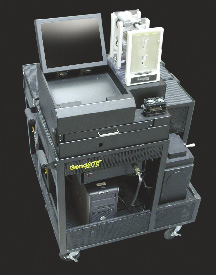 |
| A microfluidic system has been developed to integrate and automate forensic short tandem repeat analysis for DNA identification. |
The CFSRU provided technical oversight and managed the externally contracted research that produced a microfluidic system, developed at Arizona State University, to integrate and automate forensic short tandem repeat analysis for DNA identification. DNA typing (“fingerprinting”) is a method of identifying individuals to a desired statistical certainty. The technique relies on measuring the number of repeating DNA base-pair units at specific locations along a person’s DNA strands. The repeating sections are known as short tandem repeats (STRs), and the DNA regions where they occur are called loci. The tandem repeats may occur 9, 11, or n times, thus resulting in a difference between individuals. The degree of difference (i.e., specificity) for a particular individual depends on the number of loci that are measured. The FBI measures repeat differences in the STRs at 13 different loci. The analysis results in a statistical certainty that is better than 1 in more than the number of people that populate the earth.
DNA typing requires several processes following collection of the sample. These processes include DNA extraction, amplification of the STR loci and the gender locus (via the polymerase chain reaction [PCR] with a commercial kit), separation of PCR products, analysis, interpretation of the results, and provision of data in a format compatible with the national database, CODIS. The newly developed microfluidic system uses a disposable plastic cartridge, with built-in pumps and valves, that performs the differential extraction of a sexual assault sample and delivers the extracted and purified DNA for STR amplification within 2.5 hours. Manually transferring a sample through all of the steps to this point takes about 5 hours of labor by a scientist in the laboratory. The microfluidic system automates the process and cuts the processing time in half.
Creation of an Automotive Carpet Fiber Database
 |
| The Automotive Carpet Fiber Database provides the capability to use fiber evidence to identify the possible make, model, and year of automotive vehicles. Knowing the source of such fibers can enhance investigation and prosecution, especially in homicide and abduction cases. |
A fully validated Automotive Carpet Fiber Database was created and delivered to the Trace Evidence Unit in the fall of 2007. The database currently contains 766 searchable files, and each file consists of several main searchable parameters. The searchable parameters depend on the characteristics of each fiber: color, cross-sectional shape, diameter, polymer class, presence or absence of delustrant, color distribution, presence or absence of striations, illuminate values, and visible spectral peaks. As a result, questioned fibers recovered in casework may be searched by microscopic characteristics, fiber types, and/or color information to determine if a particular category of vehicle was involved in a crime. Additionally, the database can be searched by vehicle make, model, year, and/or color to determine the carpet samples that are available for comparison.
Six validation studies of the database were conducted by several different individuals to ensure the consistency of match percentages. For each validation study, 50 samples were randomly selected from the collection and subsequently mounted and analyzed. Validation studies revealed that the database produces both reliable and selective results. Results of the validation studies were presented at the 2007 National Institute of Justice/FBI Trace Evidence Symposium, held in Clearwater, Florida. A laboratory dedicated specifically for the analysis of automotive carpet fibers has now been established within the Trace Evidence Unit. To ensure continued population of the database, arrangements have been made with several automobile manufacturers to update the sample collection every year.
Visiting Scientist Program
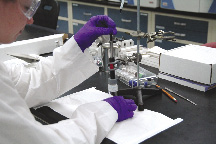 |
| A Visiting Scientist prepares a soil sample for analysis using solid-phase microextraction to study organic compounds penetrating the soil above buried human remains. Future research studies may develop analytical techniques to help field investigators locate clandestine burials. |
The Visiting Scientist Program provides a direct connection between the FBI Laboratory and academia. The program enhances the research and development capabilities of the CFSRU by providing highly qualified scientists from outside institutions to complement staff scientists and assist in performing duties consistent with the mission and needs of the unit. At the same time, university students, postgraduates, and faculty enhance their education and work experience by participating in forensic research initiatives in the CFSRU laboratories using state-of-the-art equipment.
Experienced staff scientists guide the Visiting Scientists’ research by serving as mentors. Each Visiting Scientist is assigned one or two projects focused on meeting the needs of the Laboratory’s operational units. Program participants spend three months to three years working in the CFSRU laboratories in Quantico, Virginia. During their tenure, they conduct customer-driven research, prepare and present research findings at scientific conferences, and author manuscripts for publication in peer-reviewed scientific journals.
In 2007, program funding allowed the FBI to offer this opportunity to 43 Visiting Scientists representing 32 academic institutions. Additional information on the Visiting Scientist Program is located at http://www.fbijobs.gov/242.asp.
The Dwight E. Adams Forensic Science Research Award recognizes the outstanding performance of a Visiting Scientist. It was established in 2006 to honor the commitment of Dr. Dwight E. Adams, former Director of the FBI Laboratory, to forensic science research and, in particular, to the training and development of future forensic scientists. In 2007 the award was presented to Corrie Brown, whose research efforts on the spectrochemical analysis of children’s fingerprints contributed significantly to the development of a new protocol for recovering children’s fingerprints. She also participated in the validation and expansion of the Automotive Carpet Fiber Database.
INNOVARi: Improving Laboratory Efficiency
In 2007 the FBI Laboratory continued its business process management (BPM) design and development activities to create a work-flow and information management system called INNOVARi. The purpose of INNOVARi is to manage the data collection, archiving, reporting, and performance management responsibilities of the FBI Laboratory. Through the principles of BPM, the INNOVARi program allows the Laboratory to identify and eliminate bottlenecks and objectively analyze its processes to increase efficiency and provide better service to its customers. Using a process similar to those used by FedEx and UPS to track deliveries, the FBI Laboratory uses INNOVARi to track and manage evidence as it moves through the forensic examination process.
INNOVARi uses a commercial, off-the-shelf product called BizFlow, a BPM software application that contains work-flow tools, event triggers, business logic, and process automation to analyze Laboratory processes and identify specific areas of improvement while concurrently assisting personnel in maintaining quality. INNOVARi also uses Value Stream Management, a BPM methodology that identifies the flow of activities and business units that produce value for the customer, and the “lean” concept, which focuses on identifying areas of waste in order to eliminate them.
Business Activity Monitoring (BAM) functionality is a dashboard that allows for the real-time reporting of the FBI Laboratory’s key performance indicators. Like the dashboard of a car, BAM provides instant feedback that allows the user to quickly implement the appropriate solution. Using BAM, the FBI Laboratory also will be able to track its turnaround times (both collective and individual) and caseload statistics in real time.
In 2007, five forensic examination units completed the first phase of a three-phase implementation process. An additional five to six examination units are expected to complete the second phase in 2008, with full implementation slated for late 2009.
Planning and Budget Unit
FBI Laboratory employees depend on the Planning and Budget Unit to ensure that they have the resources they need to achieve their missions. Managing resources for the Laboratory requires balancing the needs of the Division with the budgetary constraints imposed by the federal government. In 2007 this meant managing expenditures totaling nearly $89 million.
BlackBerry Initiative
In June 2007 the FBI awarded a new contract for BlackBerry equipment and telecommunications services. The new contract provided upgraded equipment and services to existing users, while allowing the Laboratory to expand its existing BlackBerry program to include additional personnel, including unit chiefs and forensic examiners. The Laboratory and other FBI Headquarters divisions located at Quantico (the Critical Incident Response Group, the Operational Technology Division, and the Training Division) were scheduled to receive the new BlackBerry devices during the week of November 26, 2007. The BlackBerry Deployment Team, which included FBI Headquarters employees and contract personnel, asked the Laboratory to provide space and to help coordinate delivery of the new devices.
A total of 791 BlackBerry devices, of which 298 were assigned to Laboratory employees, were shipped to the Laboratory and prepared for distribution by the Deployment Team and members of the Planning and Budget Unit. The process, which took several hours for each device, included programming the new equipment and transferring data between the old and new devices. At the same time, recipients received training on the features of their new equipment.
Equipped with their new BlackBerry devices, Laboratory personnel will be better and more efficient communicators and provide better service to their customers.
Special Projects Unit
The Special Projects Unit (SPU) supports FBI operations by providing accurate and timely technical, forensic, and structural services for counterterrorism, counterintelligence, criminal investigative, and forensic investigations and prosecutions. Services provided by the SPU include three-dimensional (3-D) digital survey and scanning of event venues and crime scenes; shooting-scene and bullet trajectory documentation and reconstruction; GIS (geographic information system) mapping; photographic image manipulation and retouches; facial imaging to include composite drawings, facial reconstructions from human remains, and age progression of photographs; visual-aid materials; creation of 2- and 3-D models; computer-based animation; digitally interactive demonstrative evidence; and expert consultations regarding available unit technical assistance. As illustrated by the following cases, technology has a central role in every aspect of the SPU’s work.
Crime Scene Survey, Documentation, and Reconstruction
During the year, SPU personnel prepared numerous scene reconstructions in both two and three dimensions. In order to prepare many of these scene reconstructions, SPU personnel traveled to the site of the incident and physically surveyed and documented the scene. This documentation was gathered using a wide array of equipment and methodologies that ranged from a conventional tape measure, to handheld laser range finders, to digital Total Stations, to state-of-the-art 3-D laser scanners. The data collected during these surveys was used by unit personnel to produce scaled reconstructed images of the scenes.
 |
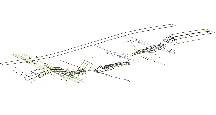 |
| Aerial photograph of the collapsed I-35 Bridge in Minneapolis, Minnesota |
The “raw” survey data collected by the Evidence Response Teams |
SPU personnel work closely with the operational entities within the Laboratory and with field response personnel. The collapse of the I-35W Bridge in Minneapolis, Minnesota, serves as a prime example of the teamwork between the SPU and the field. On August 1, 2007, this heavily traveled, eight-lane bridge that crosses the Mississippi River collapsed during rush hour. Local authorities contacted the FBI and requested assistance in the investigation and documentation of the collapse.
Three field Evidence Response Teams (ERTs) equipped with Total Stations responded, as did two supervisory special agents from the Laboratory’s Evidence Response Team Unit (ERTU), an ERT dive team, and three SPU personnel. Two of the SPU personnel used a 3-D laser scanner to document the area of the collapse and surrounding areas. The other SPU employee worked as the central point of contact (POC) for the ERTs. The POC reviewed and began the process of combining the data collected by each of the ERTs, the Minnesota State Police, the Minnesota Department of Transportation, and the Hennepin County Sheriff’s Office. A 3-D digital reconstruction of the bridge is being prepared from this data.
Area Familiarization and Special-Event Support
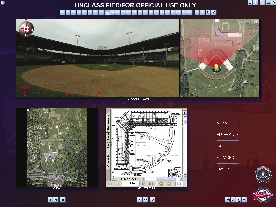 |
 |
| Visual presentation of the Little League World Series situational awareness package |
Color laser scan of the University of Phoenix Stadium in Glendale, Arizona, site of Super Bowl XLII |
SPU provides operational, command, on-scene, and tactical personnel with a comprehensive overview of a specific venue, route of travel, and other important related information. The support provided by the SPU comes in the form of 3-D laser scanning and lidar (light detection and ranging), 360-degree spherical video capture, panoramic photography, GIS mapping, and digitally interactive presentations.
In coordination with the Special Events Management Unit of the FBI’s Counterterrorism Division, the National Geospatial-Intelligence Agency (NGA), field office special-event agents, and other Laboratory entities, SPU personnel travel to the site of an event and conduct a digital survey of the requested area(s). The imagery captured and compiled through these efforts is processed, put into a final operational format, and sent to the requester. In 2007, the SPU supported many events, including the Bowl Championship Series in Phoenix, Arizona; the Major League Baseball All-Star Game in San Francisco, California; the Little League World Series in Williamsport, Pennsylvania; and the NCAA World Series in Omaha, Nebraska.
Demonstrative Evidence
Most of the SPU’s services directly support FBI investigations and prosecutions. Many of the items prepared as investigative support are used later as demonstrative evidence in court proceedings. Historically, these items would be created either by hand or by computer and produced as enlarged hard-copy charts, maps, diagrams, and other items. However, the courts are becoming more acclimated to the use of digital demonstrative evidence. Accordingly, the SPU employs new processes to provide the courts with the most relevant and accurate data available. Such was the case in the slaying of Pennsylvania State Police corporal Joseph Pokorny.
|
|
|
| Diagram created of the crime scene following the shooting of Cpl. Joseph Pokorny in Pittsburgh |
Three-dimensional rendering depicting the trajectory of the first shot to Corporal Pokorny |
Three-dimensional scale model of a courthouse in Atlanta, Georgia |
In the early morning hours of December 12, 2005, Corporal Pokorny was attacked by the subject(s) of a car he had stopped. One of the occupants of this vehicle, Leslie Denier Mollet, used Corporal Pokorny’s weapon to fire three fatal shots into him. The FBI’s Pittsburgh Field Office asked the SPU to prepare virtual visual aids of the scene and the shooting. These aids digitally incorporated a diagram, map, crime scene photographs, and data collected by the Pittsburgh ERT using a Total Station. This information was compiled into one presentation that depicted the location of the vehicles and the location and placement of pertinent evidence and data, as well as the events of the shooting, including the bullet trajectories.
Using the relevant information, the SPU created a digitally interactive presentation. The user could click on a “hot spot” within the scene diagram or map, and a photograph or image relevant to that particular location would appear. This feature was used to provide the court with a realistic overview of the scene.
However, the most dramatic piece of demonstrative evidence was a 3-D reconstruction of the actual shooting. This reconstruction was developed using the photographs of the scene and the victim, the physical evidence, and the information provided by the medical examiner. From this information, SPU personnel were able to reconstruct, in 3-D, the virtual shooting of Corporal Pokorny. This 3-D imagery was used during the trial by the prosecution—in particular, by an internationally known forensic pathologist—to explain the events of the shooting.
Using new, recently acquired technology, the SPU has the ability to produce high-quality and extremely accurate 3-D physical models of crime scenes or objects. Three laser cutting systems, a router table cutting system, a 3-D printer, and a Stereo Lithography-Rapid Prototyping System all have a computer interface that allows unit personnel to send any type or complexity-level 2-D or 3-D file to them. Once received, the file is transformed from its digital format to a physical object. At that point, the object may be complete or it may be incorporated into another larger object, such as a model of a building or vehicle.
With this technology, the SPU can design or replicate almost any type of object, including explosive devices. Laboratory explosives experts have used these models to testify in court and to train explosives technicians and investigators.
Forensic Facial Imaging
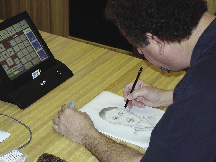 |
| A visual information specialist creates a composite drawing of a suspect during a remote witness interview being conducted via the Video Teleconferencing Center. |
The war on terrorism has brought about a marked increase in the number of requests for high-resolution facial imagery and digital image manipulation, including the preparation of artist composite drawings, facial age progressions, 2-D and 3-D facial reconstructions from skeletal remains, and photographic retouches. The SPU has been providing this type of support for more than 60 years; however, because of automation and technology, many areas of facial imaging have undergone dramatic changes.
For example, the advent of the Video Teleconferencing Center (VTC) has enabled SPU visual information specialists (VISs) to conduct witness and victim interviews almost anywhere in the world without leaving the unit. For example, investigators and military personnel in Iraq and Afghanistan need to readily identify terrorist suspects. Often, a trained VIS can interview witnesses and create composite drawings of these individuals. However face-to-face meetings may not be practical. If the witness can be brought to a safe facility with a compatible VTC, the VIS can conduct a remote interview. This process has been used with great success and has resulted in both the identification and capture of al-Qaeda terrorists and other wanted suspects.
Digital photographic retouching also has proved beneficial in identifying terrorist suspects. As military personnel search various locations in Afghanistan and Iraq, they find numerous photographs of known and suspected terrorists. It is suspected that many of the individuals depicted in the photographs alter their appearance to better blend in with the general population. To enable the investigators and soldiers to better identify these individuals, suspect images are sent to the SPU. Visual information specialists digitally alter the photographs based on the information provided by the field. These alterations include removing such items as tribal clothing, headwear, and facial hair; altering hairstyles; and adding Westernized clothing and hairstyles. With these altered images taped to the dashboards of their “Humvees,” the troops have been able to identify, capture, and neutralize many al-Qaeda suspects and other known terrorists.
Human skeletal remains can be the basis for the identification of an unknown subject or victim. Working with the Laboratory’s Trace Evidence Unit, SPU personnel have been able to put faces on human skulls and subsequently develop 2-D and/or 3-D facial reconstructions of unknown individuals. These reconstructions have resulted in the identification of individuals who otherwise would have remained unidentified.
Chemical-Biological Sciences Unit
The Chemical-Biological Sciences Unit (CBSU) was created in 2002 to support the FBI’s number-one priority, protection of the United States from a terrorist attack. The CBSU is charged with developing and enhancing the ability of the FBI to conduct forensic examinations of evidence collected from a terrorist act involving weapons of mass destruction (WMD). This mission continues to bring new capabilities to the Laboratory.
Because WMD material cannot be examined on-site at the FBI Laboratory, the CBSU has developed partnerships with a broad network of government agencies, private industry, and academic laboratories, each with a wide range of analytical capabilities. The CBSU works with partner laboratories to develop analytical plans for examining evidence. These plans incorporate validated methods to meet admissibility standards in the U.S. legal system and any other jurisdictions that rely on the Laboratory’s results. The CBSU, on behalf of the FBI Laboratory, has fostered partnerships with such entities and agencies as the U.S. Department of Homeland Security’s National Bioforensic Analysis Center; the U.S. Department of Health and Human Services’ Centers for Disease Control and Prevention (CDC); and the Center for Food Safety and Applied Nutrition of the U.S. Food and Drug Administration.
The ability to conduct traditional forensic examinations on evidence contaminated with chemical, biological, and radiological material is critical for FBI investigations. Evidence collected following a terrorist event may contain latent fingerprints, trace materials, residual DNA, or distinctive paints or dyes associated with items used in the preparation of a weapon. Examination of contaminated evidence is performed by the members of the Hazardous Evidence Analysis Team (HEAT), a program administered by the CBSU. With 62 representatives from every caseworking unit at the FBI Laboratory, the HEAT comprises examiners, scientists, and other professional staff members who have been trained to safely work in the specialized partner laboratories. The team can deploy on short notice to examine evidence contaminated with chemical, biological, or radiological materials. The CBSU coordinates training and equipment for HEAT members, and in 2007, four HEAT training sessions were held at three partner laboratories.
 |
| An FBI Laboratory examiner analyzes an improvised explosive device contaminated with a biological weapon. |
To support HEAT evidence examinations, the CBSU has partnered with the Department of Homeland Security and the Department of Defense to construct the Sample Receipt Facility (SRF) in Edgewood, Maryland. The SRF is a unique facility that combines the expertise of the U. S. Army’s Edgewood Chemical Biological Center, the FBI Laboratory, and the Department of Homeland Security’s Chemical Security Analysis Center to provide multiagency cooperation in the prevention and investigation of chemical and biological terrorism. To protect the United States and its allies from WMD-related terrorism, the SRF will provide a single facility capable of receiving, assessing, and examining highly hazardous items that may contain chemical and/or biological agents. The large forensic laboratory suite will allow forensic analysis of evidence collected in WMD terrorism cases. The analytical space will permit full characterization of specific chemical and biological material. The secure administrative space will house several database resources with information on chemical weapons production, formulation, and synthetic pathways.
A “topping off” ceremony held in October 2007 was attended by Senators Benjamin Cardin and Barbara Mikulski, Congressional Representatives Wayne Gilchrest and “Dutch” Ruppersberger, and representatives from the FBI, Homeland Security, and the Department of Defense. Senator Cardin’s remarks accurately captured the significance of the SRF:
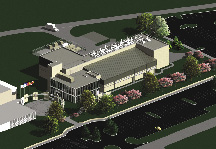 |
| An aerial depiction of the Sample Receipt Facility |
The Sample Receipt Facility is a great example of government cooperation and cost-savings. Instead of building separate facilities to support similar missions, three government agencies are pooling their resources and creating an even better facility that will serve a unique national need. This will be the only place in the United States where a sample about which nothing is known can be received and triaged.
Case support represented an important element of the activities of the CBSU in 2007. Biologists coordinated the analysis of evidence collected from WMD cases involving biological threat agents and toxins. In a case from Nashville, Tennessee, local and federal law enforcement were alerted to the possibility that William Matthews, a former law enforcement officer from Davidson County, was producing ricin and pipe bombs. Homemade explosive devices, firearms, and silencers were seized along with a container of ricin. Matthews was charged and eventually pleaded guilty to the possession of ricin, firearm silencers, and explosives.
The Nuclear Program of the CBSU provided assistance in several cases involving radiological or nuclear materials and has continued in its efforts to establish and strengthen associations with other government agencies in order to assist FBI investigations involving radiological materials.
The CBSU participated in several national, multiagency training exercises designed to assess the ability of the U.S. Government to respond to a national emergency involving WMD materials. The largest exercise with CBSU involvement was TOPOFF 4. TOPOFF stands for “Top Officials,” and this fourth exercise in the series was constructed to be a test of the national response plan. The scenario for TOPOFF 4 involved approximately 15,000 participants from international, federal, state, local, and territorial entities, and the scenario venues ranged from Arizona to Oregon to Guam. A CBSU staff member was part of the Domestic Event Support Team in Portland, Oregon.
An Agroterrorism Comprehensive Integrated Training Exercise was held in Seattle, Washington, in September 2007. CBSU staff gave presentations on the analysis of evidence contaminated with a foreign animal disease. The overall goal of the exercise was to test the response activities to a terrorist attack upon the agriculture sector and to engage FBI field agents, veterinarians, public health officials, and local law enforcement in responding to an actual event.
 |
| Electronmicrograph of the foot-and-mouth disease virus, a highly virulent pathogen in cattle, pigs, and sheep |
The Chemistry Program of the CBSU continued to develop and expand its contacts with other government agencies and thereby increase the capabilities of the FBI Laboratory to analyze chemical weapons or chemical threat agents. The CBSU Chemistry Program has been involved with chemists at the CDC concerning the mission and activities of the Chemical Laboratory Response Network and Environmental Laboratory Response Network, a network of laboratories equipped to rapidly respond to acts of terrorism and other public health threats and emergencies involving chemical, biological, radiological, and other hazardous materials. The Chemistry Program also supported CBSU casework involving biological toxins.
CBSU personnel have been active as advocates and instructors in the field of WMD forensics. CBSU personnel have participated in meetings hosted by the CDC, the Association of Public Health Laboratories, the U.S. Department of Agriculture, and the American Society for Microbiology. CBSU personnel also participated in an international meeting hosted by the Swedish Defence Research Agency on the forensic analysis of evidence contaminated with chemical, biological, or radiological threat materials and attended the annual meeting of the International Society for Forensic Genetics in Copenhagen, Denmark.
Evidence Response Team Unit
 |
| Rocket-propelled grenades uncovered at an overseas location |
For more than 15 years, the Evidence Response Team Unit (ERTU) has supported the operations of the Evidence Response Teams in all 56 FBI field offices. These teams have grown in size over the years and currently consist of 1168 primary team members. The ERTU uses science and technology to provide training, crime scene equipment and supplies, and on-scene support and forensic science expertise to the ERTs. In this way, the ERTU prepares and enables the ERTs to collect intelligence in a professional, competent, and systematic manner during evidence-recovery operations that support FBI priority investigations. The ERT Program performed nearly 2700 responses and operations during 2007. The unit also provides specialized forensic science training to the FBI, law enforcement, and evidence-collection specialists from other domestic and international law enforcement agencies, supporting the investigative priorities of the FBI and the law enforcement community.
The ERT Program represents a critical element in the FBI’s core function of collection. When terrorists and other criminals plan or conduct illegal acts, they leave behind vital intelligence. This particular type of intelligence cannot be fully exploited and analyzed unless it is collected correctly, often using sophisticated technology. Specialized experience and advanced training and technology make ERTs the ideal resource for intelligence collection.
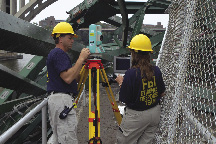 |
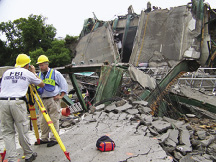 |
| ERT personnel assisted in the aftermath of the Minneapolis bridge collapse by providing advanced site documentation using laser transit surveying systems. |
ERT personnel assisted in the documentation of the Minneapolis bridge collapse, working side by side with personnel from many other agencies, including the National Transportation Safety Board. |
In addition to their evidence-collection capabilities, ERTs often are called upon for humanitarian missions, such as the Columbia Space Shuttle disaster in 2003 and the Southeast Asian tsunami in 2004/2005. The most recent example saw field and Headquarters ERT personnel deploy to Minneapolis following the tragic bridge collapse in 2007. ERT personnel provided a variety of services, to include scene mapping and victim recovery.
In addition to supporting the intelligence-collection efforts of FBI field office ERTs, the ERTU has developed a program whereby other intelligence collectors, for example, specialized FBI tactical units and Department of Defense entities, are trained using some of the same collection skills and technology. This initiative is an example of how the ERTU supports the FBI core functions of information dissemination and integration. The program includes training and consultation to help others establish protocols for processing crime scenes and conducting Sensitive Site Exploitation (SSE) operations. Although specific SSEs cannot be disclosed for security reasons, SSEs have been conducted in Iraq and Afghanistan at known terrorist locations to gather physical evidence related to the terrorist’s identity and activities.
ERTU Specialized Response Capabilities
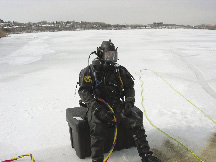 |
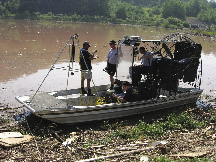 |
| FBI USERT divers routinely operate in adverse conditions as they search for evidence. |
The typical USERT dive operation requires specialized watercraft in support of the mission. |
In some cases, evidence and intelligence are hidden underwater. The FBI’s Underwater Search and Evidence Response Teams (USERTs) are the resource with the technological equipment and expertise to locate that intelligence and bring it to the surface. In 2007, ERTU’s USERT Program supported approximately 30 underwater evidence operations in FBI, state, and local investigations. These missions also included humanitarian operations such as the recovery of bodies following the Minneapolis bridge collapse.
The Forensic Canine Program (FCP) includes the Victim Recovery Team (VRT) and the Human Scent Evidence Team (HSET). This newly established canine program will develop the most proficient canine resources available in law enforcement by conducting scientific research and providing field-based training and continuing education to further the intelligence-collection capabilities of the field ERTs and other law enforcement and intelligence agencies. This program also involves the Scientific Working Group on Dogs and Orthogonal Detection Guidelines (SWGDOG), which is developing a compliance certification standard to identify capable teams for use by the FBI and the National Center for Missing and Exploited Children.
The Human Scent Evidence Team uses specially trained canines that can detect human scent on items thought to be associated with subjects or victims and then use this scent to identify subjects and, if possible, eliminate them as suspects. Properly employed, the HSET is a great asset that can minimize unnecessary investigative efforts and significantly reduce the number of work hours required to complete certain investigative steps.
The Victim Recovery Team uses specially trained canines to detect and recover victims of criminal activity.
The VRT also works closely with SWGDOG.
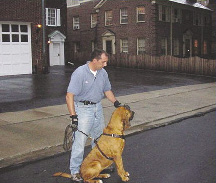 |
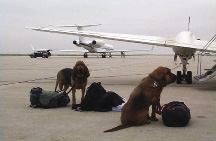 |
| ERTU’s Forensic Canine Program includes canines specially trained for human scent and victim recovery operations. |
Human Scent Evidence Team bloodhounds are routinely deployed to support law enforcement operations around the country. |
The ERTU has coordinated the joint deployment of ERT, USERT, and forensic canine resources to various locations. ERTU personnel also provided on-scene support during search operations. Whether working at the site of a hazardous crime scene, mass disaster, or missing-person case or training others to do the same, ERTU personnel have the knowledge, experience, and resources to support the FBI’s mission in an ever-evolving environment.
Hazardous Materials Response Unit
The Hazardous Materials Response Unit (HMRU) provides scientific, technical, and investigative support in response to crimes and suspicious activities involving WMD-related materials. Established in 1996, the HMRU has a staff of 42, including scientists with doctoral and other advanced degrees in biology, chemistry, and nuclear materials; paramedics; specialists in hazardous materials operations; and supervisory special agents. In 2007 the HMRU deployed on 51 missions, completed 109 scientific assessments, and provided operational advice via 186 conference calls. The HMRU provides operational support in every phase of a WMD terrorism investigation, including scientific assessments for the investigation, support to FBI tactical and render-safe teams, crime scene processing, hazardous evidence transportation, and support to other FBI Laboratory units for material attribution.
The HMRU established a national program of training, equipping, certifying, and sustaining Hazardous Materials Response Teams (HMRTs) within the FBI. Members are drawn from FBI field offices and include special agents, FBI professional support staff, and state and local law enforcement personnel serving with the Joint Terrorism Task Force (JTTF) of the local field offices. Presently, there are HMRTs in 27 of the FBI’s 56 field offices, plus an added three satellite HMRTs in the Anchorage, Honolulu, and San Juan Field Offices.
The HMRU provides various specialized training for FBI personnel and other law enforcement officials. This includes assisting the Defense Threat Reduction Agency (DTRA) in conducting WMD counterproliferation training for law enforcement personnel in the former Soviet Union and other Eastern European nations.
For Better or Worse
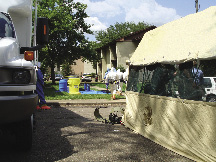 |
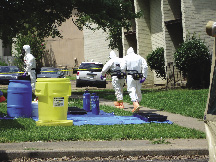 |
| Hazardous Materials Response Unit personnel use protective clothing and equipment to recover evidence at the apartment of a couple accused of manufacturing the toxin ricin. |
In the summer of 2006 the HMRU and the New Orleans Field Office HMRT responded to support the FBI’s Jackson Field Office during the investigation of a married couple suspected of manufacturing the toxin ricin. In cooperation with and supported by Jackson police, fire, and emergency medical service personnel, as well as Mississippi WMD Civil Support Teams, HMRU personnel entered the couple’s apartment to recover potential evidence.
The health and safety of all personnel on the site was a priority for the HMRU—not only because of the potential exposure to ricin but also because of the extreme heat conditions present for personnel working in protective clothing. Temperatures reached 95 degrees with a relative humidity of 87 percent, for a calculated heat index of 143 degrees. All personnel completed the mission safely, and in December 2007, the suspects pleaded guilty under the Biological Weapons Anti-Terrorism Act for attempting to produce ricin.
Photographic Operations and Imaging Services Unit
The photographic services provided by the Photographic Operations and Imaging Services Unit (POISU) represent an important component of the FBI’s and the Laboratory’s missions. The unit’s three separate programs—Operations and Training, Photographic Equipment and Support, and Photographic Services—offer a variety of services, including operational, investigative, and forensic photography; technical assistance; equipment procurement and repair; and forensic image training. The unit also supports local, state, federal, and international law enforcement investigations by providing investigative and forensic photography, imaging, and photographic processing.
The Operations and Training Program serves the Laboratory, FBI Headquarters divisions, and all FBI field offices. Scientific and technical photographers assigned to this program deploy to major crime scenes, agent-involved shootings, and other operational or investigative events, often providing photographic services at crime scenes involving chemical, biological, radiological, nuclear, or explosive devices. A large percentage of the FBI’s photographic training is provided by personnel in the Operations and Training Program.
Personnel assigned to the Photographic Equipment and Support Program design and install photographic camera concealments; procure, disseminate, and repair photographic equipment; manage equipment upgrades in the FBI’s 56 field offices; and oversee all photographic production, which includes more than 1.5 million images in both hard-copy and digital form. Three regional photographic minilabs—in Atlanta, Chicago, and San Francisco—are managed through the Photographic Equipment and Support Program. Additionally, personnel photograph special events, provide official photographs of FBI executives, and commemorate anniversaries and retirements for FBI personnel.
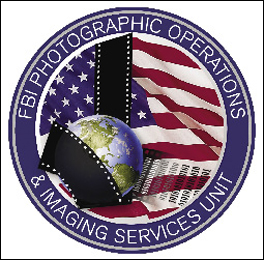 The Photographic Services Program encompasses the Tactical Site Survey Program, the Aerial Photography Program, and the Technical Imaging Group (TIG). Personnel assigned to the Tactical Site Survey Mission help the FBI’s Hostage Rescue Team, Special Weapons and Tactic Teams, and other government agencies plan for events and emergencies by creating virtual walk-throughs. To support investigative and tactical planning, aerial photographs can be geo-referenced, embedded with geographic information system data, and overlaid with an alphanumeric grid. Photographers in the TIG support the Latent Print Operations Unit, capturing, processing, and printing high-quality images of latent fingerprints. Technical Imaging Group photographers also capture a high volume of latent impressions for the Terrorist Explosive Device Analytical Center.
The Photographic Services Program encompasses the Tactical Site Survey Program, the Aerial Photography Program, and the Technical Imaging Group (TIG). Personnel assigned to the Tactical Site Survey Mission help the FBI’s Hostage Rescue Team, Special Weapons and Tactic Teams, and other government agencies plan for events and emergencies by creating virtual walk-throughs. To support investigative and tactical planning, aerial photographs can be geo-referenced, embedded with geographic information system data, and overlaid with an alphanumeric grid. Photographers in the TIG support the Latent Print Operations Unit, capturing, processing, and printing high-quality images of latent fingerprints. Technical Imaging Group photographers also capture a high volume of latent impressions for the Terrorist Explosive Device Analytical Center.


